Contents
Module User Manual

VisorPhone™ Module
User Guide

ii
Copyright
Copyright © 2000 Handspring, Inc. All rights reserved. Handspring, Springboard, Visor,
VisorPhone, the Handspring logo, and the Springboard logo are trademarks of Handspring,
Inc., and may be registered in some jurisdictions. Graffiti, HotSync, and Palm OS are registered
trademarks of Palm, Inc. or its subsidiaries. All other trademarks are the property of their re-
spective owners.
Disclaimer and limitation of liability
Handspring, Inc. and its suppliers assume no responsibility for any damage or loss resulting
from the use of this guide.
Handspring, Inc. and its suppliers assume no responsibility for any loss or claims by third parties
which may arise through the use of this software and hardware. Handspring, Inc. and its suppli-
ers assume no responsibility for any damage or loss caused by deletion of data as a result of mal-
function, dead battery, or repairs. Be sure to make backup copies of all important data on other
media to protect against data loss.
Important: Please read the Handspring End User Software License Agreement in the back of
this guide before using the accompanying software program(s). Using any part of the software
indicates that you accept the terms of the Handspring End User Software License Agreement.
Part #: 50-0227-00

Contents iii
Contents
Getting Started.................................................................................1
Step 1: Set up your handheld computer.............................................2
Step 2: Get to know your phone ........................................................3
Step 3: Insert your SIM card..............................................................5
Step 4: Connect the phone to your handheld....................................6
Step 5: Charge the battery..................................................................7
Step 6: Turn on your phone...............................................................8
Step 7: Activate your account.............................................................9
Congratulations ................................................................................10
Making Calls..................................................................................11
Calling a speed dial number.............................................................12
Dialing a number with the Dialpad .................................................13
Redialing the last number ................................................................14
Redialing previous numbers.............................................................14
Calling a number in your Address Book..........................................15
Dialing a number from other applications.......................................16
Returning a missed call.....................................................................17
Calling an emergency number .........................................................18
Receiving Calls...............................................................................19
Answering the phone........................................................................20
Responding to call waiting ...............................................................21
Forwarding calls ...............................................................................22

iv Contents
Handling Multiple Calls...................................................................23
Placing a call on hold .......................................................................24
Dialing another number while a call is on hold ..............................25
Switching between two calls ............................................................26
Using 3-way calling..........................................................................27
Checking Messages ........................................................................29
Reviewing missed calls .....................................................................30
Checking voicemail ..........................................................................31
Checking text messages....................................................................32
Displaying call history......................................................................33
Purging call history ..........................................................................34
Managing Your Speed Dial List .......................................................35
Defining speed dial buttons .............................................................36
Adding an Address Book entry to your speed dial list.....................37
Changing a speed dial entry.............................................................38
Deleting speed dial entries ...............................................................39
Arranging the speed dial list.............................................................40
Working With SMS Text Messages ..................................................41
Viewing messages .............................................................................42
Replying to messages .......................................................................43
Creating messages ............................................................................44
Creating message greetings and signatures .....................................47
Setting message options ...................................................................48
Saving incoming messages ...............................................................48
Modifying messages .........................................................................49

Contents v
Copying message text .......................................................................49
Forwarding incoming messages .......................................................50
Sorting messages...............................................................................51
Deleting messages ............................................................................52
Enabling SMS Email........................................................................53
Using VisorPhone as a Wireless Modem..........................................55
Establishing a TCP/IP connection with VisorPhone .....................56
Preparing for a direct wireless HotSync operation .........................57
Preparing for a network wireless HotSync operation .....................58
Performing a wireless HotSync operation.......................................59
Customizing Your Phone.................................................................61
Setting dialing prefixes .....................................................................62
Assigning dialing applications ..........................................................63
Changing the phone display.............................................................64
Selecting the ringer settings.............................................................65
Preventing unauthorized use............................................................66
Disabling call waiting .......................................................................67
Blocking your phone number for outgoing calls.............................68
Selecting a service provider network................................................69
Connecting a headset .......................................................................70
Using the Menus ............................................................................71
Phone application Edit menus .........................................................71
Phone application Record menu......................................................71
Phone application Options menu.....................................................72
SMS Message Manager application Message menus.......................73

vi Contents
SMS Message Manager application Edit menu...............................74
SMS Message Manager application Option menu..........................75
Troubleshooting and Maintenance...................................................77
Caring for your VisorPhone module...............................................82
Caring for the battery ......................................................................83
How do I dispose of the battery? .....................................................84
Warranty and Other Product Information ........................................85
Handspring, Inc. Limited Warranty ...............................................85
Handspring, Inc. End User Software License Agreement..............88
Canadian RFI Statement..................................................................93
Acknowledgments ............................................................................93
Index .............................................................................................95

Getting Started 1
Getting Started
Congratulations on the purchase of your new VisorPhone™ module. Your
VisorPhone module integrates the power of a state-of-the-art digital mobile
phone with the simplicity of your Handspring handheld computer. Your
VisorPhone includes all of the most popular features such as speed dial and
call screening. Plus, it handles multiple calls, sends and receives text
messages, and fully integrates with your handheld to take advantage of your
existing Address Book.
To use your VisorPhone, you must first establish an account with a mobile
phone service provider.
Your account information is located on your SIM (Subscriber Identity
Module) card. If a SIM card did not come with your VisorPhone, your
service provider will provide one when you subscribe to their service. Your
SIM card must be inserted into your VisorPhone before you can use it.
Just follow the seven easy steps in this chapter to get up and running quickly.
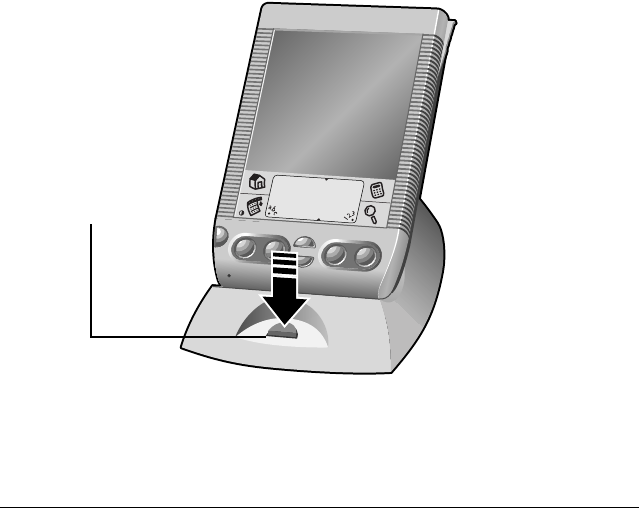
2 Getting Started
Step 1: Set up your handheld computer
1. If you haven’t already set up your handheld, follow the steps that came
with your handheld to set it up.
2. (Recommended) Synchronize your handheld with your computer.
Tip: If you need additional information about synchronizing, refer to the
Quick Reference guide and Visor Handheld User Guide that came with
your handheld.
Place your handheld
in the cradle and
press the HotSync
button
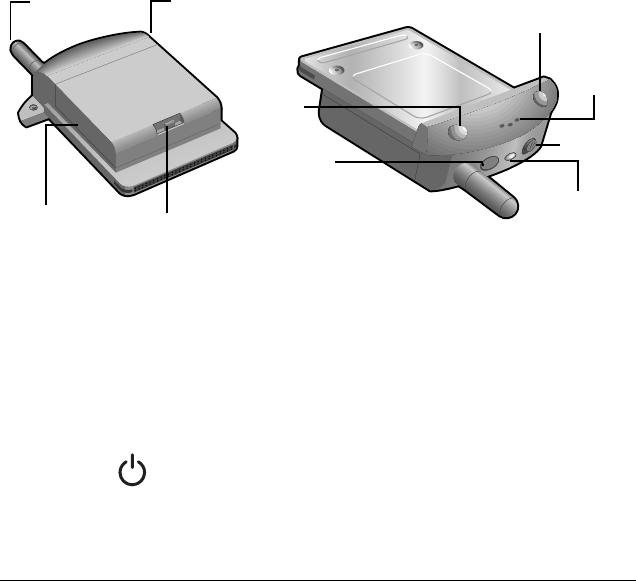
Getting Started 3
Step 2: Get to know your phone
Antenna Receives and sends signals on your VisorPhone. The
antenna does not telescope out of the phone.
Headset jack Enables you to connect a headset so you can view your
handheld screen while talking on the phone.
Battery Powers your VisorPhone.
Battery latch Secures the battery to your VisorPhone.
Power
button
Turns on your VisorPhone and activates the signal.
Your phone stays on until you remove it from your
handheld or press the power button to turn it off.
Antenna Hea
d
set jac
k
Battery latch
Power
button
Speaker
Phone
button
SMS Message
Manager button
LED
Slider
Battery

4 Getting Started
Speaker Functions as the earpiece on your VisorPhone.
Tip: To adjust the volume during a call, press the
scroll buttons on the front of your handheld.
Phone
button
Turns on your handheld and starts the Phone
application. If another application is running, press this
button to switch to the Phone application. If the phone
is ringing, press this button to answer calls.
SMS
Message
Manager button
Turns on your handheld and starts the SMS Message
Manager application so you can view, send, and receive
text messages.
Slider Controls the ringer setting. See “Selecting the ringer
settings” on page 65 for details on changing the settings.
LED Provides status information for your VisorPhone. The
color of the light and the blink state indicate the status
as follows:
No light = Phone off
Red/solid = Charger on; battery charging
Green/solid = Charger on; battery fully charged
Red/slow blink = Phone on; no network service
Green/slow blink = Phone on; in service
Red/fast blink = Battery low
Green/fast blink = Data call active
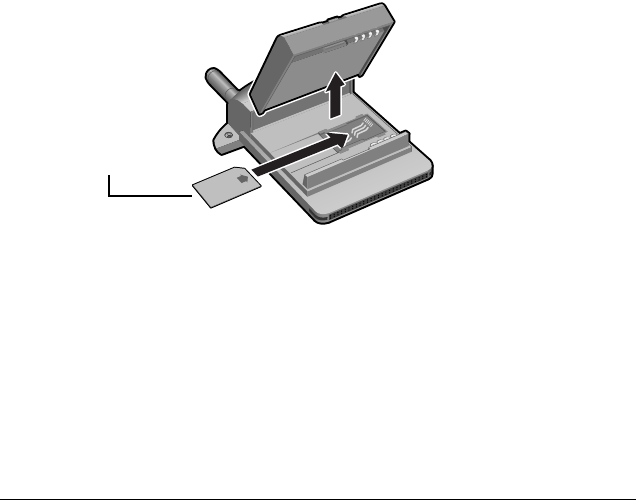
Getting Started 5
Step 3: Insert your SIM card
Note: If your SIM card is already inserted in your phone, skip to Step 4.
1. If the battery is attached, press the latch and remove the battery.
2. Insert the SIM card into the slot.
3. Place the battery onto your phone and secure the latch.
Tip: Since calls are billed to your telephone number, you can move your
SIM card to any mobile phone that uses a SIM card, and the calls
will be billed to your account.
Slide the SIM
card into the slot
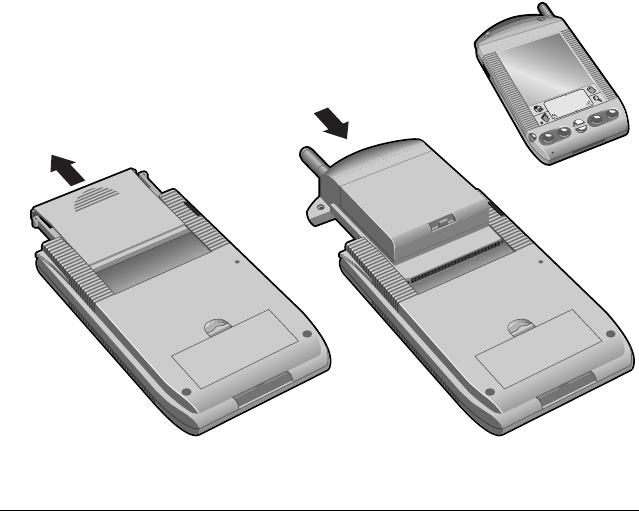
6 Getting Started
Step 4: Connect the phone to your handheld
1. Remove the slot protector from your handheld.
2. Insert your VisorPhone module into the Springboard™ expansion slot
until it clicks into position.
Tip: To remove your VisorPhone from your handheld, simply slide it out
from the Springboard expansion slot.
Slide the slot
protector away
from your
handheld
Slide the module into
the Springboard
expansion slot
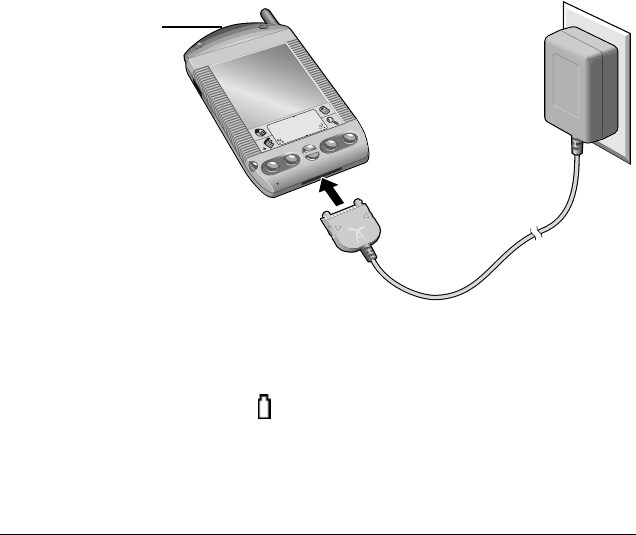
Getting Started 7
Step 5: Charge the battery
1. Plug the travel charger into a wall outlet.
2. Insert the travel charger cable into the connector on your handheld.
Tip: Your VisorPhone must be in your handheld while charging. It takes
about 1.5 hours to fully charge the battery. It’s time to charge the
battery when you observe one of the following:
■the battery gauge in the top-right corner of the Phone
application appears empty
■the LED turns red and blinks quickly
■the LED does not turn on when you turn on your phone
LED turns so
l
i
d
re
d
when charging
and solid green
when charged
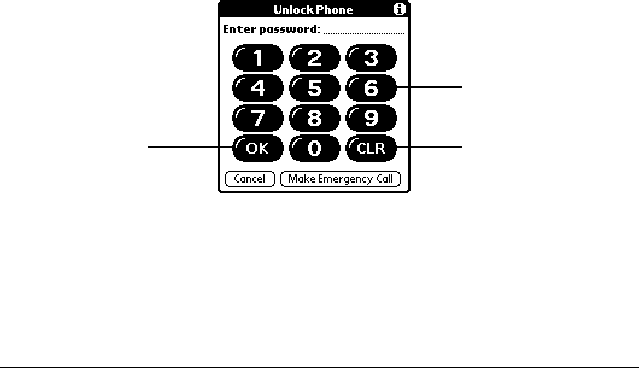
8 Getting Started
Step 6: Turn on your phone
After the battery is charged, you can begin using your phone.
1. Press the Power button on your VisorPhone for two seconds until you
hear a beep.
2. If the Unlock Phone dialog appears, enter the default password assigned
by your service provider and then tap OK. See your service provider’s
documentation for the default password.
Note: If you are using a SIM card from an established account, enter
your existing password.
Tip: See “Preventing unauthorized use” on page 66 to learn about
setting your own password.
Tap numbers to
enter password
Tap OK unlock
your phone Tap CLR to erase
the last number
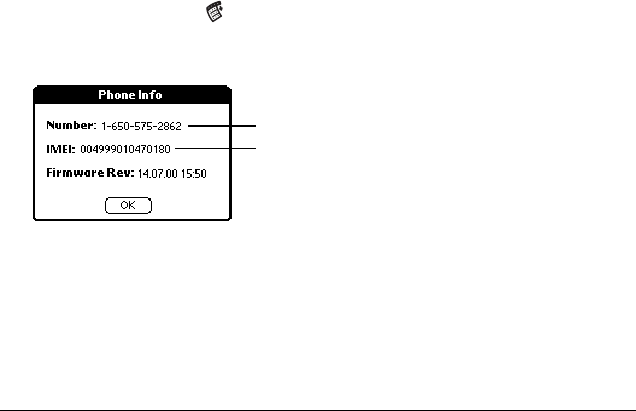
Getting Started 9
Step 7: Activate your account
If you received a new SIM card with your phone, you may need to call your
service provider to activate your account. Your service provider’s phone
number is located on the materials that came with your VisorPhone
module.
Once you receive your phone number, it may take a few hours to become
fully active. Some service providers send a special message with your phone
number. Follow these steps to check the phone number:
1. Tap the Menu icon .
2. Under Options, tap Phone Info.
3. Tap OK.
Your VisorPhone number
Your equipment ID number

10 Getting Started
Congratulations
You’re ready to use your VisorPhone module. Keep these things in mind as
you use your new phone:
■If you travel outside a coverage area, your phone remains on but you
can’t make or receive calls. If this occurs, the LED blinks red slowly and
the phone periodically tries to register to the network. When you return
to a coverage area, the LED blinks green.
■If you travel outside a coverage area, you can’t receive SMS text
messages. However, the messages are stored by the network and you will
receive them when you return to a coverage area.
■Your account includes a voicemail feature so people can always leave you
a message even when your phone is off.
■Always use care when operating a mobile phone. If you plan to use your
VisorPhone module while driving a car, we recommend using a headset
for hands-free operation. See “Connecting a headset” on page 70 to
learn how to connect a headset to your VisorPhone.
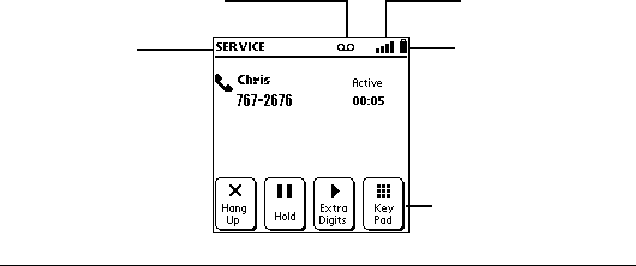
Making Calls 11
Making Calls
There are several ways to make calls with your VisorPhone. This chapter
describes how to dial a number by:
■Selecting it from your speed dial list
■Entering it on the Dialpad
■Selecting it from your Call History list
■Selecting it from your Address Book
■Dialing from another application
■Returning a missed call
■Dialing an emergency number
After you dial and establish a connection, the Active Call screen appears:
Tap the Key Pad to
enter extra numbers
such as a PIN code
or an extension
Network name
Voicemail notification icon Signal strength icon
Battery gauge
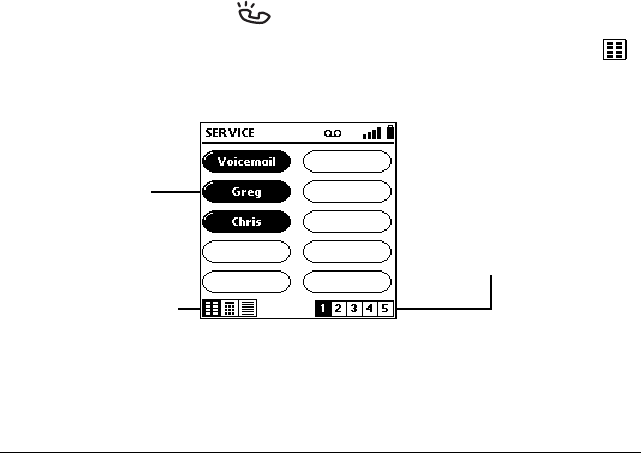
12 Making Calls
Calling a speed dial number
Speed dialing enables you to quickly place a call without entering the
number. This is particularly useful for numbers you call often, such as your
home or office.
Note: This section assumes you’ve already created a speed dial list. To
learn how to add numbers to your speed dial list see “Defining speed
dial buttons” on page 36.
1. Press the Phone button on your VisorPhone.
Tip: If the screen below doesn’t appear, tap the Speed Dial icon .
2. Select the number you want to call.
Tip: After you make the connection the Active Call screen appears.
If prompted to enter a menu selection, tap Key Pad. If you
defined any Extra Digits, such as an extension, tap Extra Digits.
3. Tap Hang Up to end the call.
Tap a button to
dial a number
Tap a Page icon
to view other
speed dial pages
Speed Dial, Dialpad,
and Call History icons
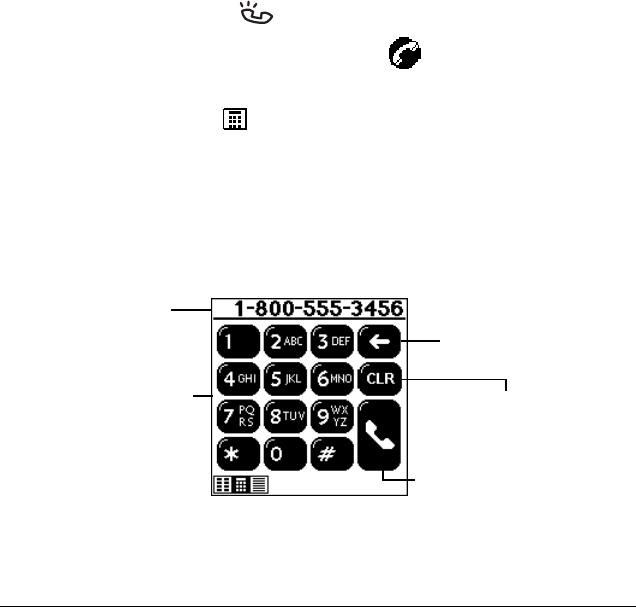
Making Calls 13
Dialing a number with the Dialpad
1. Press the Phone button on your VisorPhone.
Tip: You can also tap the Phone icon in the Applications
Launcher to start the Phone application.
2. Tap the Dialpad icon .
3. Dial the number. If you are dialing an international number, tap the +
key before entering the number to automatically insert the international
access code upon dialing.
Tip: To display the last ten numbers dialed, press the scroll buttons
on the front of your handheld.
Tip: To edit the phone number, tap the Dial box and then use the
keypad, Graffiti® writing, or the onscreen keyboard.
4. Tap Hang Up to end the call.
Tap CLR to delete
the entire entry
Tap Backspace to
erase the last digit
Tap a digit to enter
it in the dial box
Tap Send to dial the
number in the dial box
Dial box
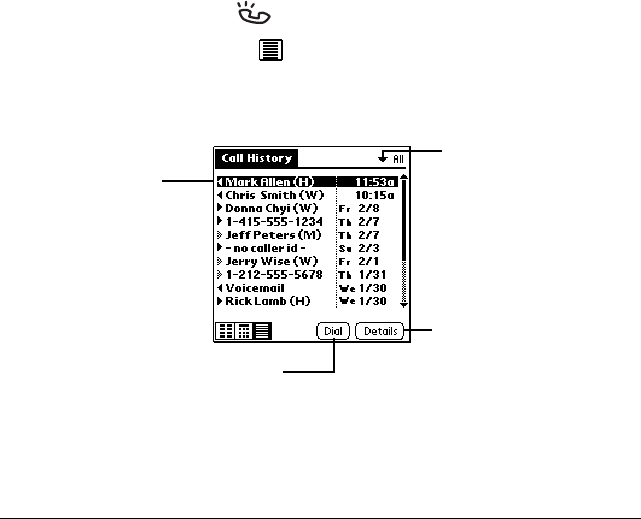
14 Making Calls
Redialing the last number
■Hold down the Phone button for two seconds to redial the last number
you called.
Redialing previous numbers
1. Press the Phone button on your VisorPhone.
2. Tap the Call History icon to view a list of previous incoming and
outgoing calls.
3. Select the number you want to call.
4. Tap Dial.
Tip: To add a number to your Address Book or Speed Dial list, tap
Details, tap Copy Phone #, then in Address Book or the Speed Dial
list, select Paste from the Edit menu to insert the number.
Tap
h
ere to se
l
ect
the call category:
All, Incoming, Out-
going, or Missed
Tap the entry you
want to dial
Tap Dial to call selected number
Tap Details to view
call information
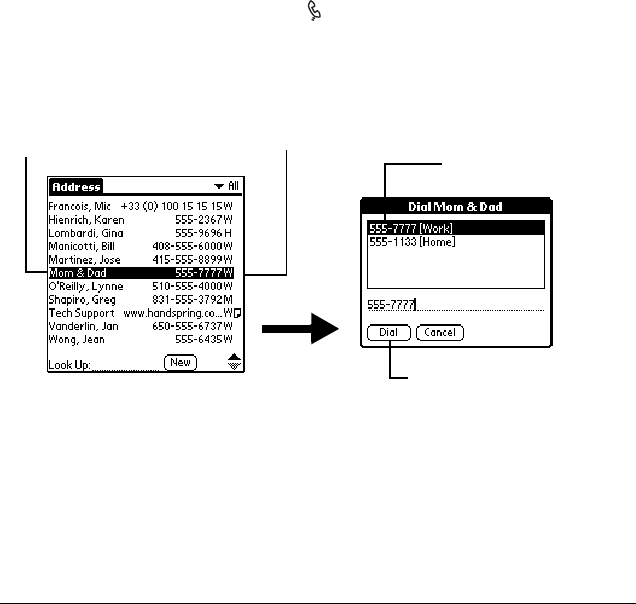
Making Calls 15
Calling a number in your Address Book
1. Press the Address Book button on the front of your handheld.
2. Select the number you want to call.
Tip: The Dial button changes to an Email button or an SMS button
based on the type of number you select in the Dial dialog. You
can assign each of these buttons to launch a different
application. See “Assigning dialing applications” on page 63
for details.
3. Tap Hang Up to end the call.
T
ap a name
to view or
edit contact
information
Tap a number
to select a
number to dial Tap a number
to select it
Tap Dial to call
the number
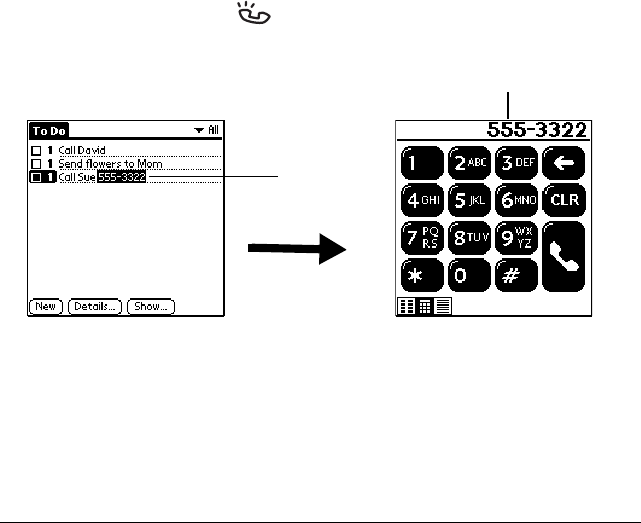
16 Making Calls
Dialing a number from other applications
You can also dial numbers from other applications such as Memo Pad or To
Do List.
1. Highlight the number you want to dial.
2. Press the Phone button on your VisorPhone.
Tip: The number automatically appears in the Dial box on the Dialpad
screen so you can edit the number if needed.
Select a
number
to dial
Tap
h
ere to a
dd
an area co
d
e
or change the number
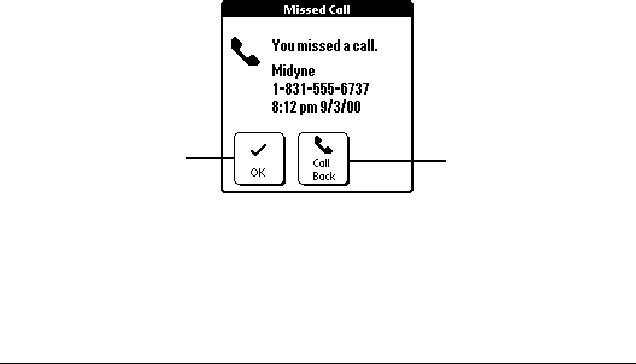
Making Calls 17
Returning a missed call
When your VisorPhone is on and you remain in a coverage area, any calls
you miss appear in the Call History list and you receive a missed call alert
message. When your phone is off or you travel outside a coverage area, your
calls are forwarded to voicemail and they do not appear in the Call History
list.
■If you miss multiple calls, a message appears indicating the number of
calls you missed. Follow the steps in “Reviewing missed calls" on page
30 to return the calls.
■If you miss a single call, the following screen appears:
Tip: If the caller’s phone number is not available, the Call Back button
does not appear on the Missed Call screen.
Tap Call Back to
dial the number
Tap OK to dismiss
the call without
calling back
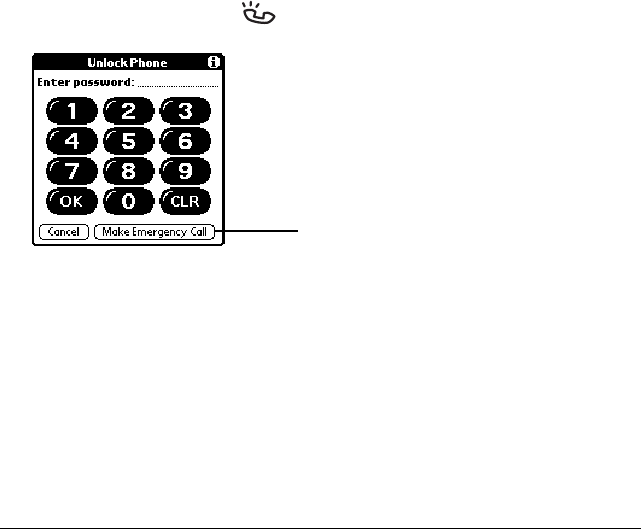
18 Making Calls
Calling an emergency number
Your VisorPhone provides easy access to the 911 or 112 emergency
numbers. You don’t need to unlock your phone or even have the SIM card
installed to call an emergency number.
■Press the Phone button on your VisorPhone.
Tip: You can also dial a 911 or 112 emergency number from the Dialpad
screen.
Tap Make Emergency Call

Receiving Calls 19
Receiving Calls
Whenever your phone is on and you are within a coverage area, you can
receive incoming calls. In addition to answering calls, you can also choose
several incoming call options. This chapter describes how to:
■Answer the phone (or reject a call)
■Respond to a call waiting prompt
■Forward your calls
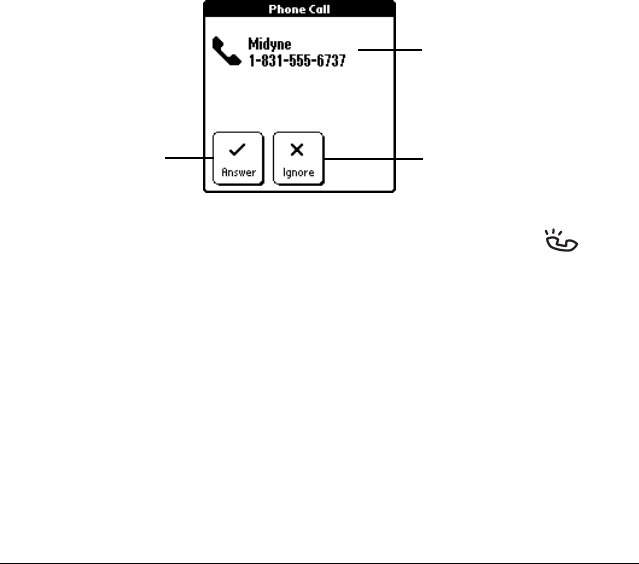
20 Receiving Calls
Answering the phone
An incoming call turns on your handheld if it is off.
Tip: You can also answer a call by pressing the Phone button while
your VisorPhone is ringing.
Caller’s name and
phone number if
available
Tap Answer to
accept the call
Tap Ignore to
send the call
to voicemail
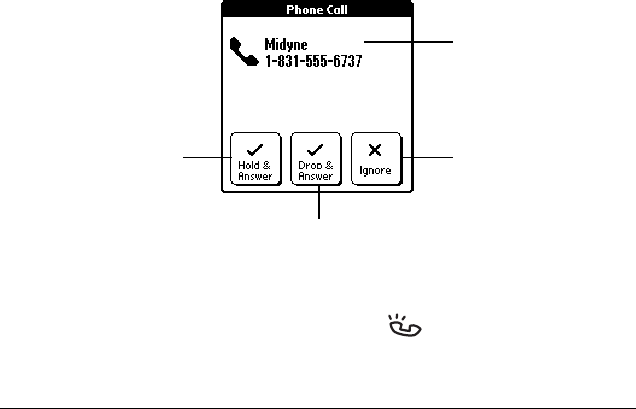
Receiving Calls 21
Responding to call waiting
When you are on the phone and receive a second call, the Phone application
updates the Active call screen and emits a Call Waiting “beep” tone.
Tip: Make sure the Disable Call Waiting option on the Call Preferences
screen is off. When this option is off the Disable Call Waiting check
box is empty. For more information on enabling and disabling call
waiting, see “Disabling call waiting” on page 67.
■When the Call Waiting dialog appears, tap the appropriate button.
Tip: You can also press the Phone button to place the first call on
hold and answer the incoming call.
Caller’s name and
phone number if
available
Tap Hold & Answer
to place 1st call on
hold and answer
incoming call
Tap Drop & Answer
to end1st call and
answer incoming call
Tap Ignore to
send the call
to voicemail
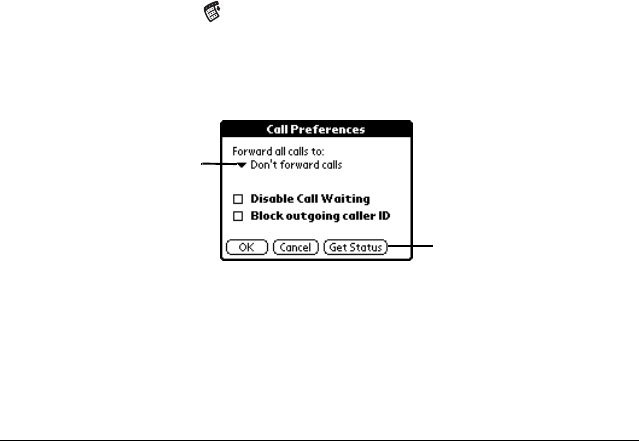
22 Receiving Calls
Forwarding calls
If you need to turn off your phone or know you are traveling outside a
coverage area, you can forward your calls to another number. Keep in mind
that your service provider will still charge you for your forwarded calls.
Note: Because call forwarding information is stored by the network, it’s a
good idea to check the current network settings both before and
after you change the call forwarding option.
1. Tap the Menu icon .
2. Under Options, tap Call Preferences.
3. Select the call forwarding option you want to use.
Tip: You can define up to five forwarding numbers including the
voicemail number assigned by your service provider. Select Edit
Number from the list to add, change, or delete a number.
4. Tap OK.
Tap here to forward
all calls to the selected
number
Tap here to display
current network settings

Handling Multiple Calls 23
Handling Multiple Calls
You can use the Hold button in the Phone application to handle a variety of
situations that involve multiple calls. During an active call, you can receive
or place another call, switch between two active calls, and create a 3-way
conference call. For example, when you’re talking to a friend, you can put
them on hold, call a restaurant to make dinner reservations, and return to
your friend to confirm the time and place. These features also enable you to
receive an important incoming call while you’re already on the phone, and
to facilitate conference calls when you’re on the go.
This chapter describes how to:
■Place a call on hold
■Dial another number while a call is on hold
■Switch between two calls
■Use 3-way calling
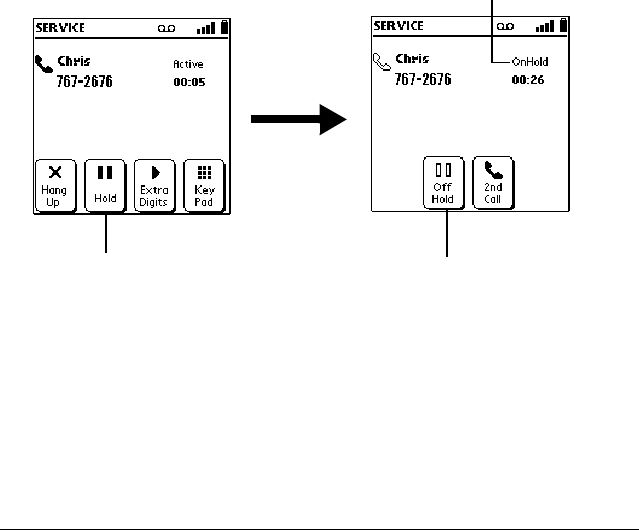
24 Handling Multiple Calls
Placing a call on hold
1. Place or answer a call.
2. Tap Hang Up to end the call.
Tap Off Hold to return
to the call
Call status
indicator
Tap Hold to put the
call on hold
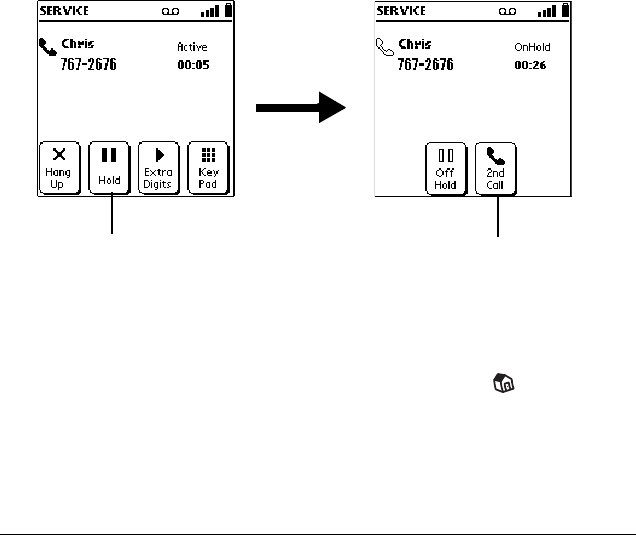
Handling Multiple Calls 25
Dialing another number while a call is on hold
1. Place or answer a call.
2. Put the call on hold.
3. Tap 2nd Call.
4. Dial the number.
Tip: You can tap the Applications Launcher icon to open
another application that has the number you want to dial.
Tap 2nd Call to access
dial functions
Tap Hold to put the
call on hold
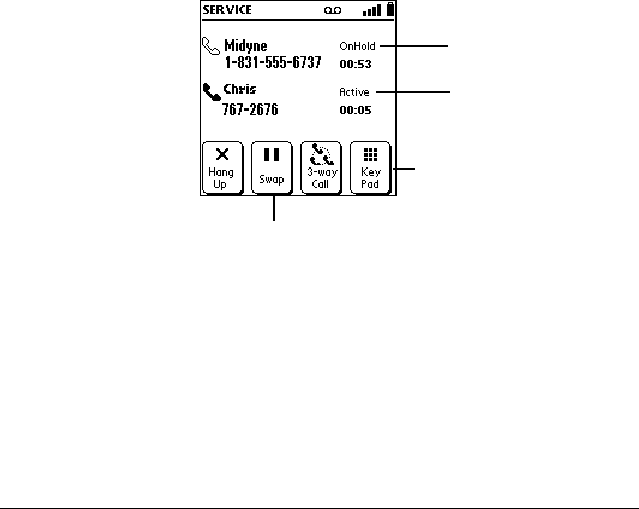
26 Handling Multiple Calls
Switching between two calls
1. Answer or place two calls. See “Dialing another number while a call is on
hold” on page 25.
2. Tap Swap, or tap the call status line to switch between calls.
Tip: If you called an automated phone system that prompts you to
enter a menu selection or phone extension, tap KeyPad to
respond to the voice prompts.
3. Tap Hang Up to end the active call.
Tap Swap to
change calls
Tap KeyPad to access a
voice prompt system
1st call status
2nd call status
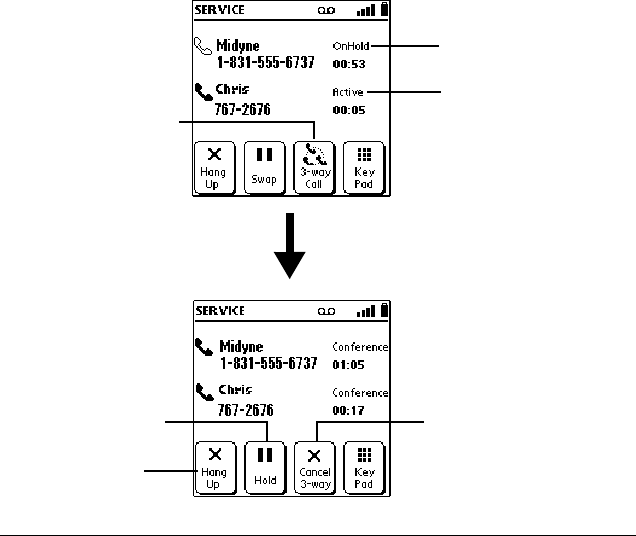
Handling Multiple Calls 27
Using 3-way calling
1. Answer or place two calls.
2. Join the two calls.
Tap 3-way Call to
speak with both calls
at the same time
1st call status
2nd call status
Tap Hang Up to
end both calls
Tap Hold to place
both calls on hold
Tap Cancel 3-way to
return to the previous
active call and to
place the other call
on hold

28 Handling Multiple Calls

Checking Messages 29
Checking Messages
Your VisorPhone is capable of receiving voicemail and text messages and
generating missed call messages.
If you miss a call when your VisorPhone is on and you remain in a coverage
area, your missed calls appear in the Call History list and you receive a
missed call alert message. When your phone is off or you travel outside a
coverage area, your missed calls are forwarded to voicemail and they do not
appear in the Call History list. Similarly, when your phone is off or you
travel outside a coverage area, your service provider stores your text
messages until you turn on your phone or return to a coverage area.
Note: You may need to contact your service provider to add the text
messaging feature to your rate plan. This feature is sometimes
referred to as SMS, or Short Message Service.
This chapter describes how to:
■Review missed calls
■Check voicemail
■Check text messages
■Display call history
■Purge call history
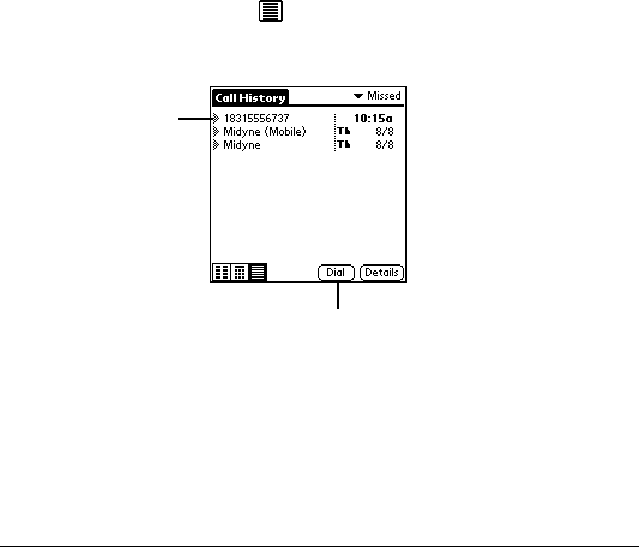
30 Checking Messages
Reviewing missed calls
When you don’t answer an incoming call, it appears under Missed calls in
your Call History list.
1. Tap the Call History icon .
2. Tap Missed in the pick list in the upper-right corner.
Tap caller’s name
or phone number
Tap Dial to return the call
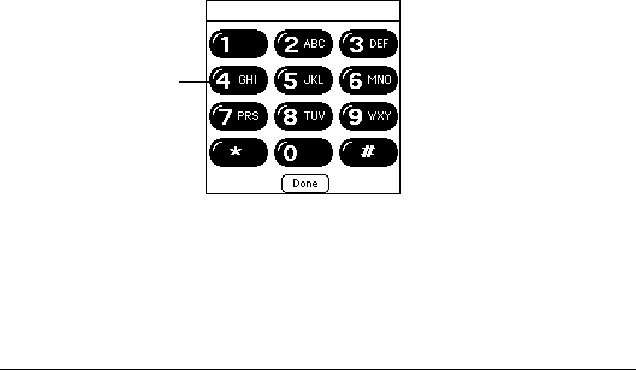
Checking Messages 31
Checking voicemail
When your phone is off, you travel outside a service area, or you miss or
choose to ignore a call, the caller may leave a voicemail message. When you
connect to the network, the phone application notifies you that you received
voicemail messages.
1. Dial your voicemail service using one of these methods:
■Tap the Voicemail button in the Speed Dial view.
■Tap Listen in the Voicemail alert dialog.
2. Tap Key Pad.
3. Tap Done.
Tap buttons to dial
access codes and
review messages
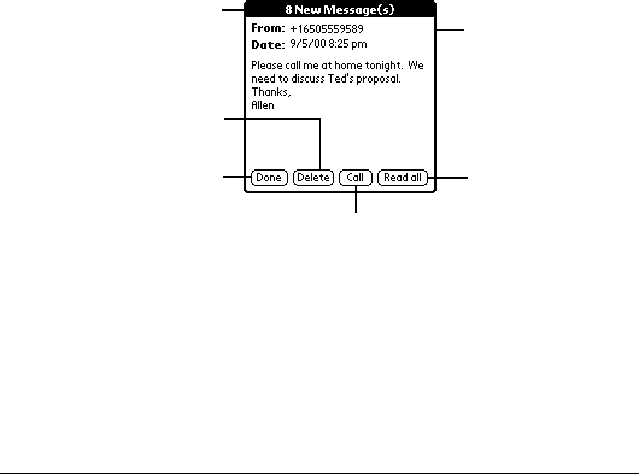
32 Checking Messages
Checking text messages
When your phone is off or you travel outside a service area, other people can
still send you text messages. Your service provider stores the messages for
you until you turn on your phone or return to a service area. When you
connect to the network, the phone application displays the first message in a
screen similar to the following:
Tip: If you have only one message, the button in the lower-right corner
changes to a Reply button. Tap this button to open the SMS
Message Manager and send an SMS reply.
Ca
ll
er’s name an
d
phone number if
available
Tap Done to review
messages later
Tap Delete to delete
the message
Num
b
er o
f
new messages
Tap Call to dial
the sender
Tap Read all to open
the SMS Message
Manager Inbox
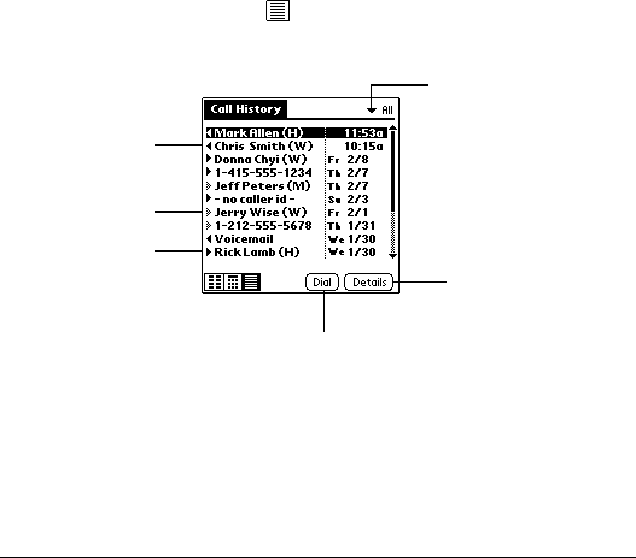
Checking Messages 33
Displaying call history
The Call History view provides quick access to the previous 1,000 incoming
and outgoing calls.
■Tap the Call History icon .
Tip: To temporarily store a number in your handheld’s memory,
tap Details, tap Copy Phone #, and then tap Done. You can
now Paste this number into any application on your handheld.
Outgoing call
Tap arrow to se
l
ect
the call category: All,
Incoming, Outgoing,
or Missed
Incoming call
Missed call
Tap Dial to call the
selected number
Tap Details to
view time and
duration
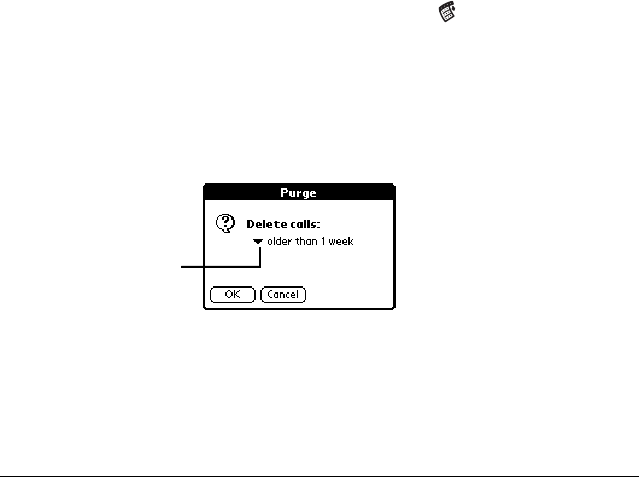
34 Checking Messages
Purging call history
Your VisorPhone continues accumulating call history information for up to
1,000 calls until you purge the call history list. To conserve storage space, we
recommend that you purge this list periodically.
Note: Using the Purge function permanently removes the calls from your
handheld. You cannot undo this process to restore the information.
1. From the Call History view, tap the Menu icon .
2. Under Record, tap Purge.
Tip: To delete a specific item, select the item from the Call History
view and tap Delete Item instead of Purge.
3. Select the purge option you want to use.
4. Tap OK.
Tap the pick list to
choose which calls
to purge

Managing Your Speed Dial List 35
Managing Your Speed Dial List
You can store up to 50 phone numbers in the speed dial list. There are five
pages of numbers that hold ten numbers per page.
Tip: Keep your speed dial list organized by storing different types of
numbers on different pages. For example, create separate pages for
family, business, friends, and emergency numbers.
This chapter describes how to:
■Assign phone numbers to speed dial buttons
■Add Address Book entries to your speed dial list
■Change speed dial entries
■Delete speed dial entries
■Arrange the speed dial list
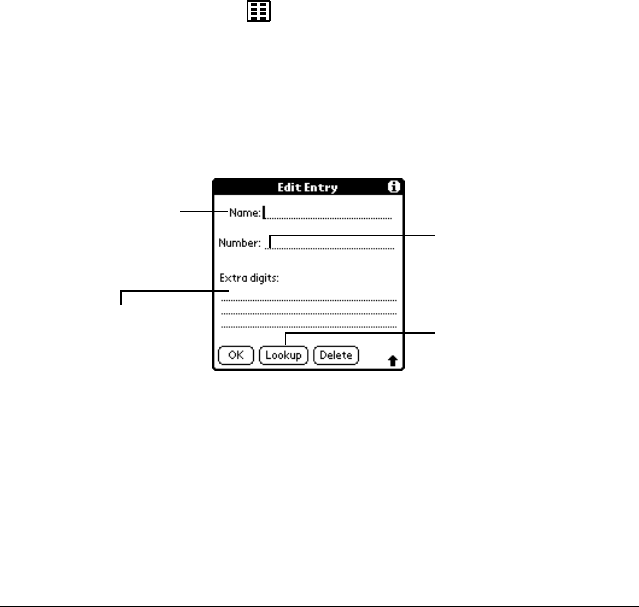
36 Managing Your Speed Dial List
Defining speed dial buttons
1. Tap the Speed Dial icon .
2. Tap a blank speed dial button.
Note: The first slot on the first Speed Dial page is reserved for your
service provider’s voicemail service number.
3. In the Edit Entry dialog, enter the Name, Number, and any Extra digits.
Tip: To insert a pause between Extra digits when dialing, enter a
comma (,). Each comma represents a one second pause.
4. Tap OK.
Enter a
name for
the button
Tap Lookup to find
a number in your
Address Book
Enter the phone
number
Enter digits to dial
after placing the call
(such as an extension
or access code)
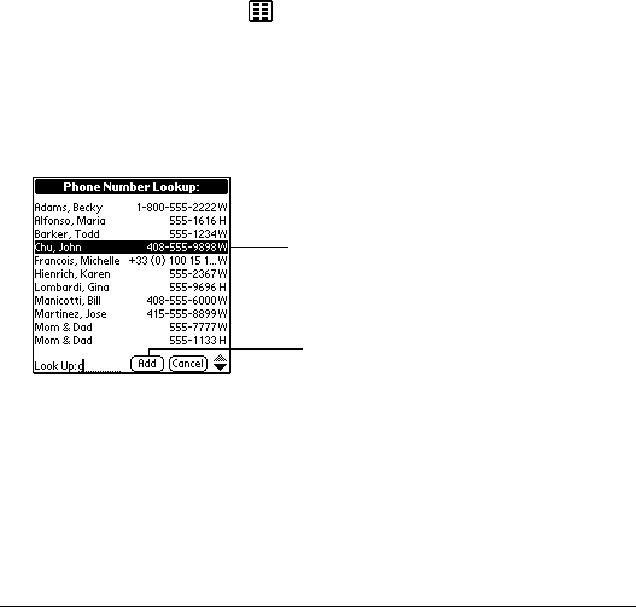
Managing Your Speed Dial List 37
Adding an Address Book entry to your speed dial list
1. Tap the Speed Dial icon .
2. Tap a blank speed dial button.
3. Tap Lookup.
4. In the Phone Number Lookup dialog, use the scroll arrows or begin
writing the person’s last name to find the number you want.
5. Tap Add.
Tip: You can edit the number or name by tapping it in the Edit
Entry dialog.
6. From the Edit Entry dialog, tap OK.
Tap a number to select it
Tap Add to insert
the number in the
speed dial entry
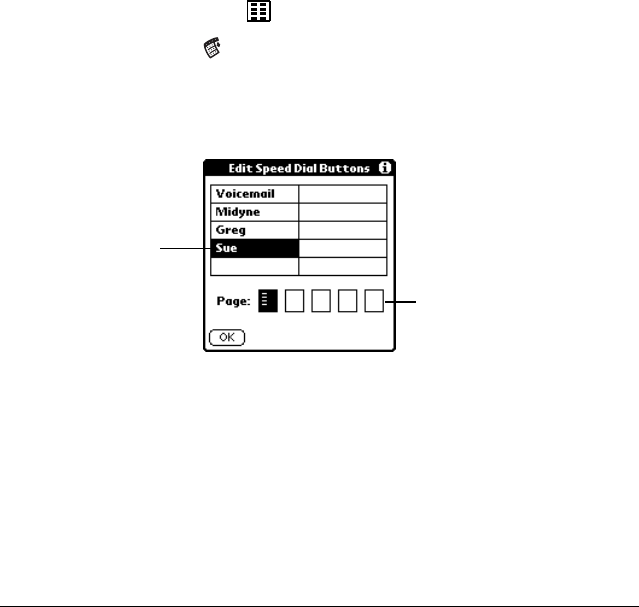
38 Managing Your Speed Dial List
Changing a speed dial entry
1. Tap the Speed Dial icon .
2. Tap the Menu icon .
3. Under Edit, tap Edit Speed Dial.
4. Select the entry you want to change.
5. In the Edit Entry dialog, enter the new information.
6. Tap OK to save the new information.
7. Tap OK again.
Tap an entry
to select it
Tap pages to view
more entries
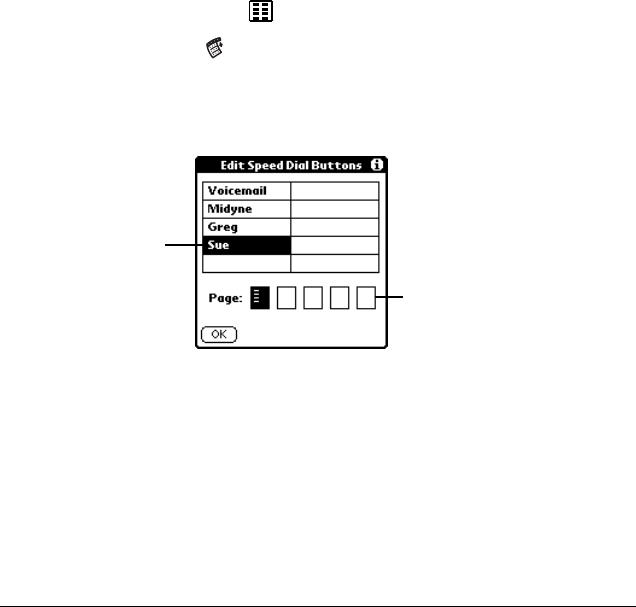
Managing Your Speed Dial List 39
Deleting speed dial entries
1. Tap the Speed Dial icon .
2. Tap the Menu icon .
3. Under Edit, tap Edit Speed Dial.
4. Select the entry you want to delete.
5. In the Edit Entry dialog, tap Delete.
6. Tap OK to confirm deletion.
7. Tap OK.
Tap an entry
to select it
Tap pages to view
more entries
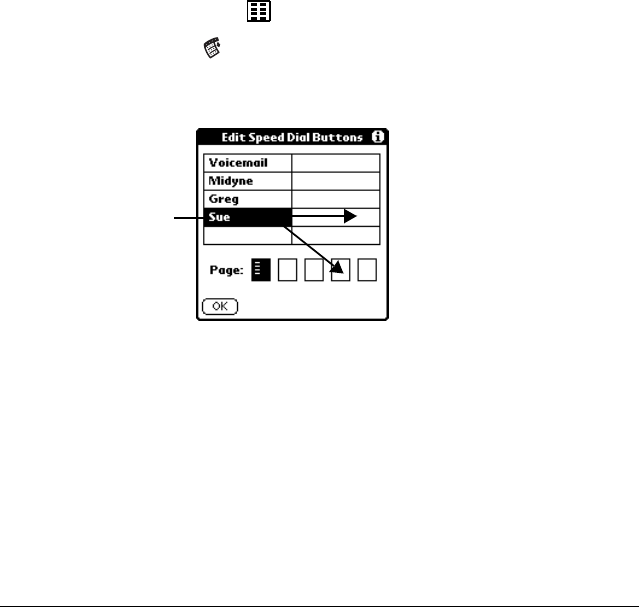
40 Managing Your Speed Dial List
Arranging the speed dial list
1. Tap the Speed Dial icon .
2. Tap the Menu icon .
3. Under Edit, tap Edit Speed Dial.
Tip: If the new slot is full, the other entries shift down one slot. The
right column fills after the left column becomes full. If you drag
an entry to a page icon, the entry moves to the first available slot
on that page.
4. Tap OK.
Drag an entry
to another slot
or page

Working With SMS Text Messages 41
Working With SMS Text Messages
In addition to dialing and receiving calls, you can use your VisorPhone to
send and receive short text messages. These text messages, also called SMS
(Short Message Service) messages, are similar to email messages that you
send and receive from your computer, but are limited to a few sentences in
length. The person receiving your message must also have a mobile phone
and a service provider that supports text messages. Some service providers
also allow you to use your mobile phone to send text messages to an email
address and to receive text messages from a computer. Talk to your service
provider for details about their SMS and SMS Email features. This chapter
describes how to:
■View messages
■Reply to messages
■Create messages
■Create message greetings and signatures
■Set message options
■Save messages
■Forward messages
■Copy message text to the clipboard
■Modify outgoing messages
■Sort messages
■Delete messages
■Enable SMS Email
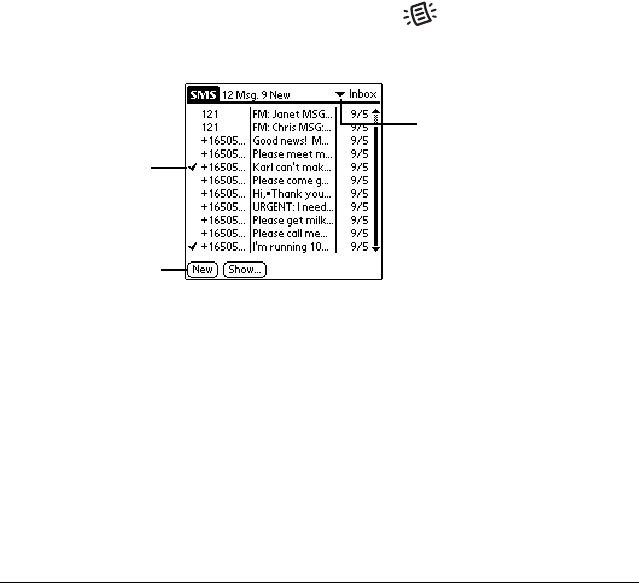
42 Working With SMS Text Messages
Viewing messages
1. Open the SMS Message Manager Inbox using one of these methods:
■Press the SMS Message Manager button on your VisorPhone.
■From a Message alert dialog, tap Read All.
Tip: When viewing Saved messages, the arrows indicate whether a
message was incoming or outgoing.
2. Tap the message you want to view.
3. Press the scroll buttons on your handheld to scroll through a message. At
the start or end of a message, it displays the next message.
4. Tap Done.
Tap New to create
a message
Tap arrow to select
the message category:
Inbox, Saved, Pending,
or Sent
Message read
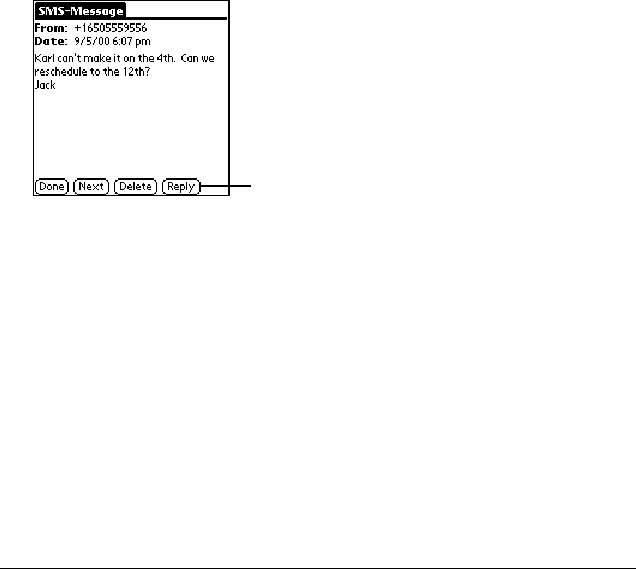
Working With SMS Text Messages 43
Replying to messages
1. Tap the incoming message to which you want to reply.
2. Tap Reply.
3. Enter the message text.
Tip: When you reply to an SMS message, the SMS Message
Manager fills in the To field for you. When you reply to an
email message, you must enter the email address on the first
line of the message. See “Creating an SMS Email message” on
page 46 for more information.
4. Tap Send.
Tap Reply to respond to the message

44 Working With SMS Text Messages
Creating messages
SMS Message Manager enables you to create short text messages and send
them to a mobile phone number or an email address. If a message exceeds
160 characters, SMS Message Manager divides the text into multiple
messages. As you create a message, the status bar indicates how many
messages will be sent and the number of characters in each message.
To save time while creating messages, you can insert predefined text from a
template. Some templates ask you to enter information such as a meeting
time or place. Using a template is similar to filling in the blanks on a form
letter instead of writing a letter from scratch. Fortunately, in SMS Message
Manager you can easily combine the template text with your own text to
personalize your message.
You can create a message at any time, but if you send a message when you
are outside a coverage area, your VisorPhone places the message in the
Pending category and sends it automatically when you return to a coverage
area. While a message is in the Pending category, you cannot edit it, but you
can delete it before it is sent.
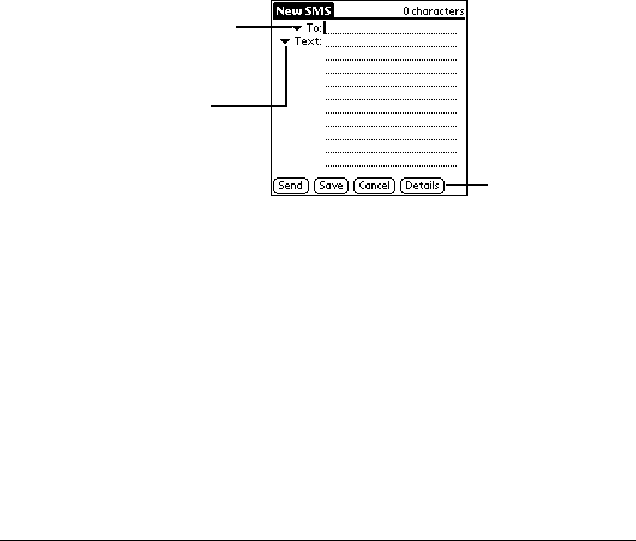
Working With SMS Text Messages 45
Creating an SMS text message
1. From any SMS Message Manager list view, tap New.
2. Address the message to a mobile phone number.
3. Enter text using Graffiti, the onscreen keyboard, or the pick lists.
4. Tap Send. (The message goes into the Pending category until your
phone transmits the message.)
Tip: To store a draft message and send it later, tap Save instead.
After your message transmits, your VisorPhone places a copy in the Sent
category. If an error occurs while sending the message, an exclamation point
(!) appears next to message in the Sent category.
Tap To to select a number
Tap Text to insert text
from a template
Tap Details to set
message options
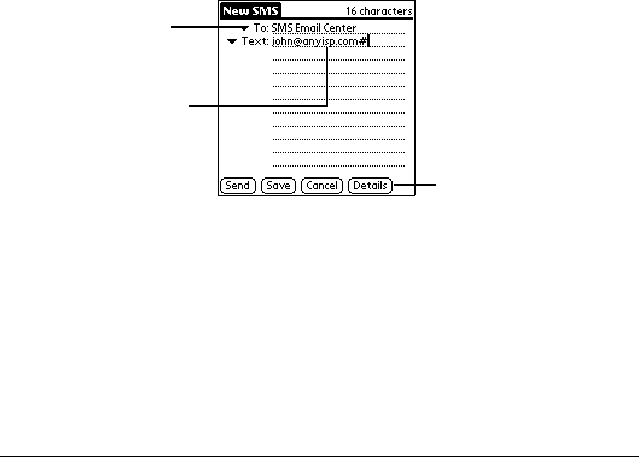
46 Working With SMS Text Messages
Creating an SMS Email message
To send a message to an email address, you must first enter your service
provider’s SMS Email Center number. See “Enabling SMS Email” on
page 53.
1. From any SMS Message Manager list view, tap New.
2. Tap the To pick list and select SMS Email Center.
3. On the first Text line, enter the recipient’s email address followed by a
space and a # symbol.
Tip: You can also select an email address in Address Book and then
tap SMS, or select an email address from the Lookup list.
4. Enter the remaining text.
5. Tap Send. (The message goes in the Pending category until it transmits.)
Tip: To store a draft message and send it later, tap Save instead.
Tap To to select
SMS Email Center
Enter email address
followed by a space
and # symbol
Tap Details to set
message options
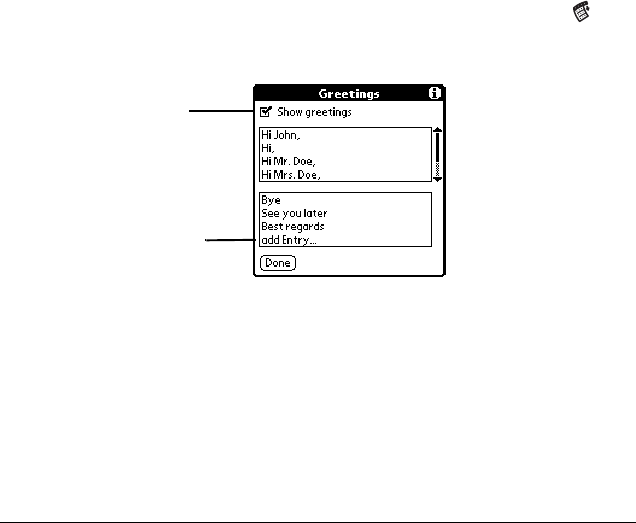
Working With SMS Text Messages 47
Creating message greetings and signatures
When you create a message you can use the greetings pick lists to insert a
greeting and signature in your message. You can also add items to these lists
or modify the existing items.
1. From any SMS Message Manager list view, tap the Menu icon .
2. Under Options, tap Greeting.
3. Tap Done.
Tap add Entry to
create a new greeting
Tap here to hide the
greetings pick lists
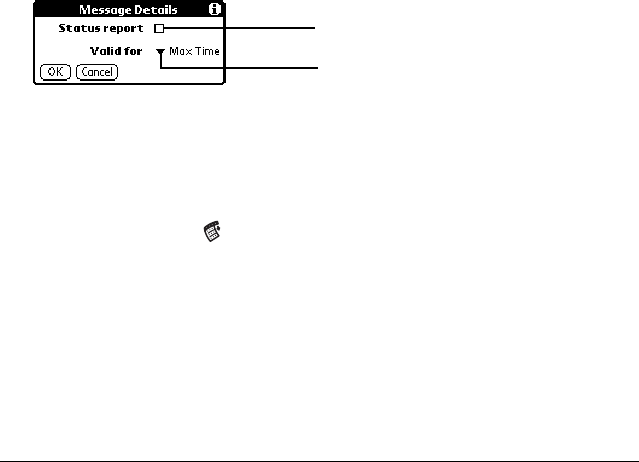
48 Working With SMS Text Messages
Setting message options
You can specify whether you want to see a status report for this message, and
the time period you want the message to remain in affect. If the recipient’s
phone is off or outside a coverage area, their service provider stores the
message until it can be delivered or until it expires, whichever comes first.
1. While creating a new message, tap Details.
2. Tap OK.
Saving incoming messages
1. Open the message you want to save.
2. Tap the Menu icon .
3. Under Message, tap Save.
Tip: Saving an incoming message moves the message from your
Inbox to the Saved category.
Tap here for status report
Tap here to set expiration

Working With SMS Text Messages 49
Modifying messages
You can modify any outgoing messages in your Saved or Sent categories.
Tip: You can create your own message template by modifying and
resending a Sent message.
1. Open the message you want to change.
2. Tap the message text, or tap Edit.
3. Edit the message.
4. Tap Send.
Tip: When modifying a message, you can keep the revised message
without sending it by tapping Save instead of Send.
Copying message text
1. Open the message you want to copy.
2. Select the text you want to copy.
3. Tap the Menu icon .
4. Under Message, tap Put Into Clipboard.
Tip: To create a memo with the text, tap Create New Note instead.
5. Open the message or application where you want to insert the text.
6. Tap the Menu icon .
7. Under Edit, tap Paste.

50 Working With SMS Text Messages
Forwarding incoming messages
1. From the Inbox or Saved category, open the message you want to
forward.
2. Tap the Menu icon .
3. Under Message, tap Forward.
Tip: You can edit the forwarded message before sending it.
4. Enter the recipient’s mobile phone number.
Note: The recipient’s phone must be SMS enabled.
5. Tap Send.
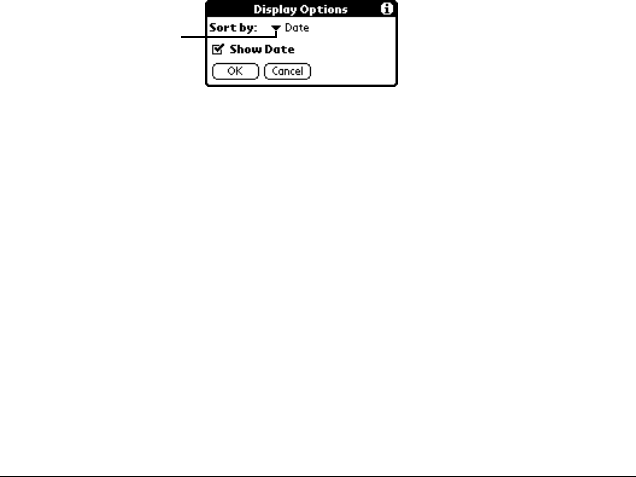
Working With SMS Text Messages 51
Sorting messages
1. In the SMS Message Manager Inbox, select the category you want to
sort.
2. Tap Show.
3. Select the sort method you want to use.
4. Tap OK.
Tip: If you sort the list by name, messages from senders that are not in
your Address Book appear at the bottom of the list in numerical
order by phone number.
Tap arrow to select
sort method
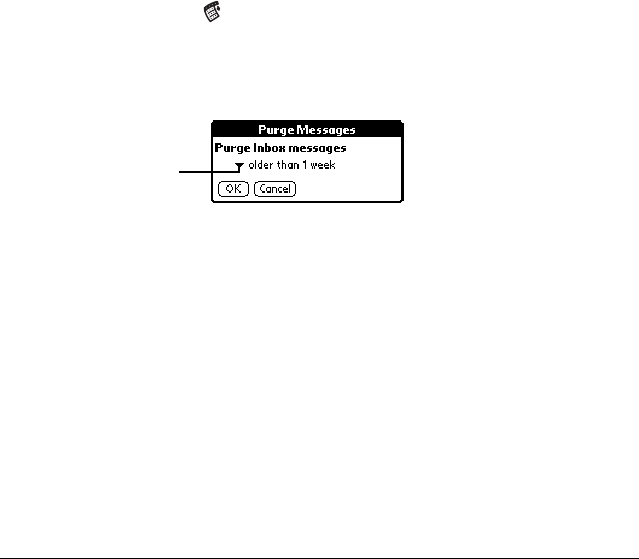
52 Working With SMS Text Messages
Deleting messages
1. In the SMS Message Manager Inbox, select the category containing the
messages you want to delete.
2. Tap the Menu icon .
3. Under Message, tap Purge.
4. Select the deletion method you want to use.
5. Tap OK.
6. Tap Yes to confirm deletion.
Tip: To delete a single message, open it and tap the Delete button.
Tap arrow to select
deletion method
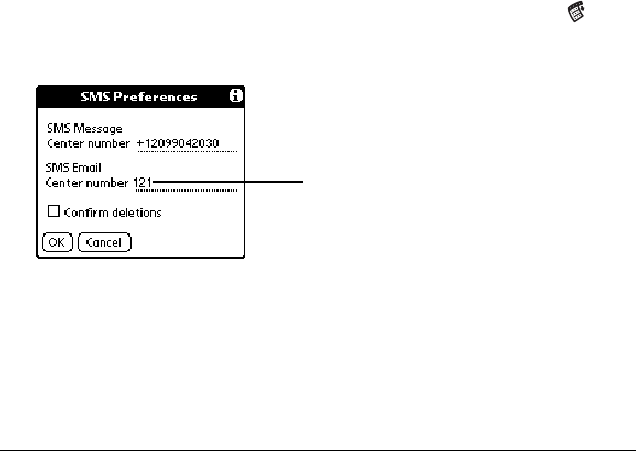
Working With SMS Text Messages 53
Enabling SMS Email
To use SMS Email you must enter the your service provider’s SMS Email
Center number. The SMS Email Center is where you send any SMS
messages that are addressed to an email address instead of a mobile phone
number. The SMS Email Center then forwards the message to the
recipient’s email address. Contact your service provider to obtain their SMS
Email Center number.
1. From any SMS Message Manager list view, tap the Menu icon .
2. Under Options, tap Preferences.
Tip: The SMS Message Center number is automatically supplied
by your service provider is read from your SIM card.
3. Tap OK.
Enter SMS Email
Center number

54 Working With SMS Text Messages

Using VisorPhone as a Wireless Modem 55
Using VisorPhone
as a Wireless Modem
In addition to using your VisorPhone as a phone, you can also use it as a
modem that operates at 14.4Kbps or 9.6Kbp, depending on the speed of
your service provider network. You can use your VisorPhone’s modem
capabilities with third-party communication software that you download
from the Internet, such as web browsers or email applications, and to
perform wireless HotSync operations when your cradle is not available.
Note: To use your VisorPhone as a modem, you must subscribe to the
data services feature from your service provider. Contact your
service provider for information on the data services feature.
This chapter describes how to:
■Establish a TCP/IP connection for use with third-party software
■Prepare for a direct wireless HotSync operation
■Prepare for a network wireless HotSync operation
■Perform a wireless HotSync operation
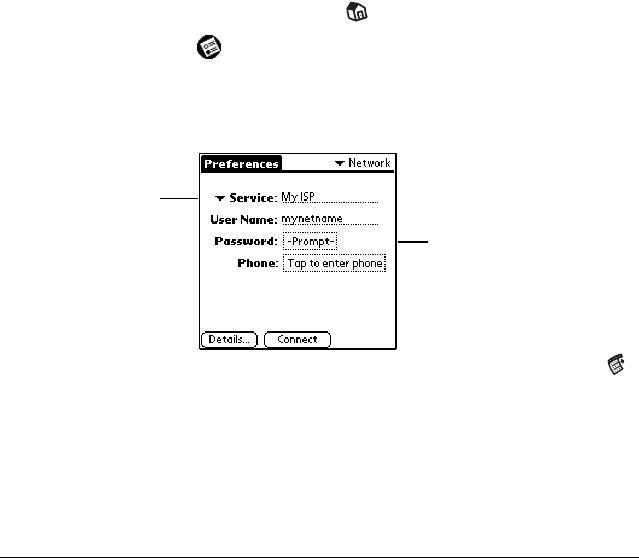
56 Using VisorPhone as a Wireless Modem
Establishing a TCP/IP connection with VisorPhone
Before using a third-party communication application, verify with the
developer that it is compatible with VisorPhone.
1. Tap the Applications Launcher icon on the front of your handheld.
2. Tap the Prefs icon .
3. Tap Network in the pick list in the upper-right corner.
4. Enter the configuration information for your ISP.
Note: If your ISP is not on the Service pick list, tap the Menu icon ,
tap New on the Service menu, and enter the service name.
5. Tap Connect and wait for a connection to establish.
6. Start the third-party application you want to use.
To learn more about using your handheld with your ISP, see “Network
Preferences and TCP/IP Software” in the Visor Handheld User Guide.
Enter your User Name,
Password, and your
ISP’s phone number
Select your ISP
from the Service
pick list
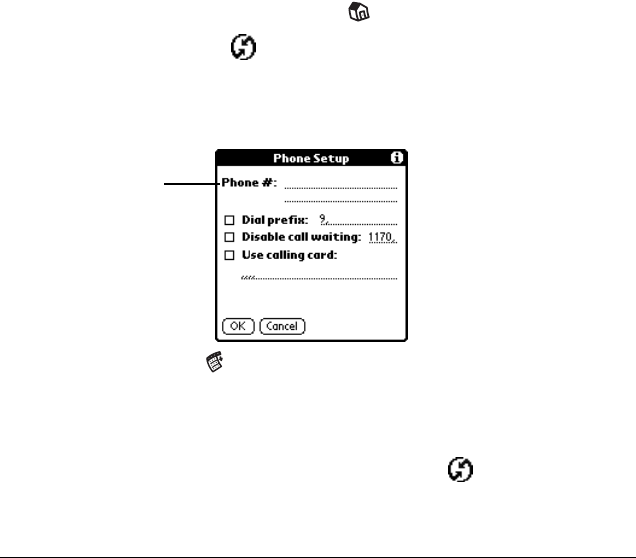
Using VisorPhone as a Wireless Modem 57
Preparing for a direct wireless HotSync operation
A direct wireless HotSync operation is when you dial a modem attached to
your desktop computer to perform a remote HotSync operation.
1. Tap the Applications Launcher icon on the front of your handheld.
2. Tap the HotSync icon .
3. Tap Enter Phone #.
4. Enter your computer modem number.
5. Tap the Menu icon .
6. Under Options, tap Modem Sync Prefs.
7. Tap Direct to modem, and then tap OK.
8. On a Windows computer, click the HotSync icon and check Modem
on the HotSync Manager menu. On a Macintosh, open HotSync
Manager and select Modem Setup on the Serial Port Settings tab.
Enter the number
used to call your
computer modem

58 Using VisorPhone as a Wireless Modem
Preparing for a network wireless HotSync operation
A network wireless HotSync operation is when you dial a modem attached
to a network, such as a server on a corporate LAN, to perform a remote
HotSync operation.
Note: This feature is not available for the Macintosh.
1. Tap the Applications Launcher icon on the front of your handheld.
2. Tap the HotSync icon .
3. Tap the Menu icon .
4. Under Options, tap Modem Sync Prefs.
5. Tap Network, and then tap OK.
6. Tap Select Service and configure the Network Preferences panel.
Note: For information on the Network HotSync feature, see
“Conducting a HotSync operation via a network” in Chapter 8
of the Visor Handheld User Guide, and for information on
configuring the Network Preferences panel, see “Network
Preferences and TCP/IP Software” in Chapter 9 of the Visor
Handheld User Guide.
7. On your desktop computer, click the HotSync icon and check
Network on the HotSync Manager menu.

Using VisorPhone as a Wireless Modem 59
Performing a wireless HotSync operation
Since your VisorPhone operates as a modem at 14.4Kbps or 9.6Kbp, a
wireless HotSync operation takes significantly longer than performing a
HotSync operation with your cradle. Therefore, we recommend
performing a wireless HotSync operation only when your cradle is not
available.
Tip: To increase the speed of a wireless HotSync operation, select
Conduit Setup under Options and reduce the number of
applications with which you synchronize.
1. Tap the Applications Launcher icon on the front of your handheld.
2. Tap the HotSync icon .
3. Tap the Modem Sync icon .
4. Wait for your VisorPhone to connect with the modem on the other end
and for the HotSync operation to finish.
Tip: If necessary, you can cancel the procedure at any time by tapping
the Cancel button

60 Using VisorPhone as a Wireless Modem

Customizing Your Phone 61
Customizing Your Phone
The Phone application Preference screens enable you to customize many of
the VisorPhone features to meet your individual needs. For example, you
can choose which view appears when you start the Phone application, and
set security options to prevent unauthorized use.
This chapter describes how to:
■Set dialing prefixes
■Reassign the buttons in your Address Book
■Change the phone display
■Select the ringer setting
■Lock the keypad
■Disable call waiting
■Block your phone number for outgoing calls
■Select a different service provider network
■Connect a headset to your VisorPhone
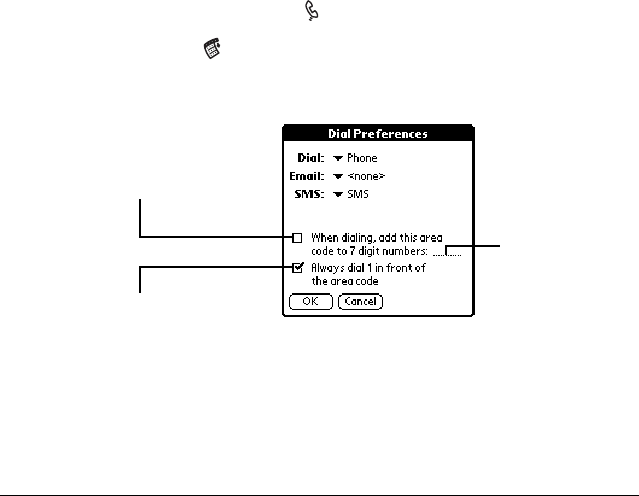
62 Customizing Your Phone
Setting dialing prefixes
Some service providers require 11-digit dialing. If you already have 7-digit
or 10-digit numbers in your Address Book, you can set your VisorPhone to
automatically use 11-digit dialing by using a default area code. Using this
feature does not change the numbers in your Address Book.
1. Press the Address Book button on the front of your handheld.
2. Tap the Menu icon .
3. Under Options, tap Dial Preferences.
4. Tap OK.
Note: You may be prompted to enter a default area code the first time you
dial a number from your Address Book.
Enter default
area code here
Tap check box to insert an
area code in front of 7-digit
numbers before dialing
Tap check box to insert a 1
in front of 10-digit numbers
before dialing
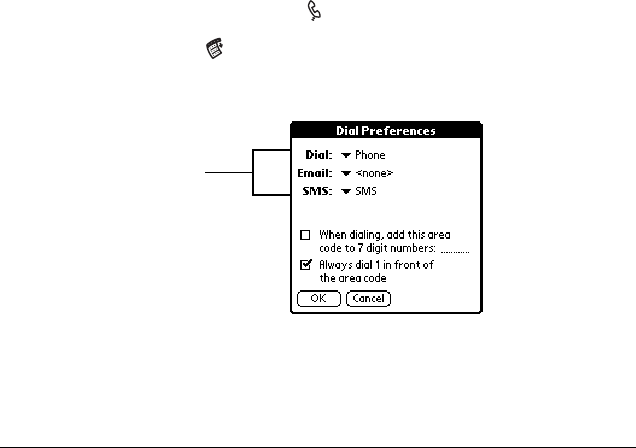
Customizing Your Phone 63
Assigning dialing applications
When you select a phone number or email address in Address Book, you can
tap the Dial, SMS, or Email buttons to direct the selected information to a
specific application. The default applications for these buttons are the
Phone application and the SMS Message Manager, but you can also assign
these buttons to any application that is compatible with the dialing-enabled
version of Address Book.
1. Press the Address Book button on the front of your handheld.
2. Tap the Menu icon .
3. Under Options, tap Dial Preferences.
4. Tap OK.
Tap pick lists to
assign an application
to that button
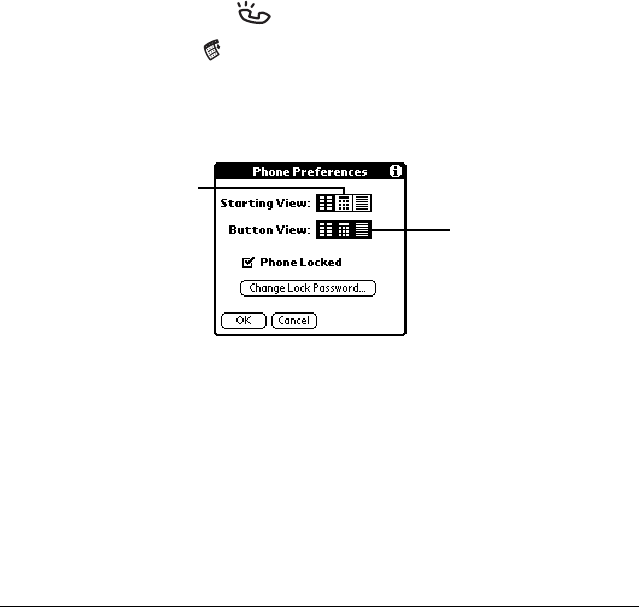
64 Customizing Your Phone
Changing the phone display
1. Press the Phone button on your VisorPhone.
2. Tap the Menu icon .
3. Under Options, tap Phone Preferences.
4. Select the display options you want to use.
5. Tap OK.
Tap the view you want
to see when you open
the Phone application Tap an icon to skip
that view when
pressing the Phone
button repeatedly
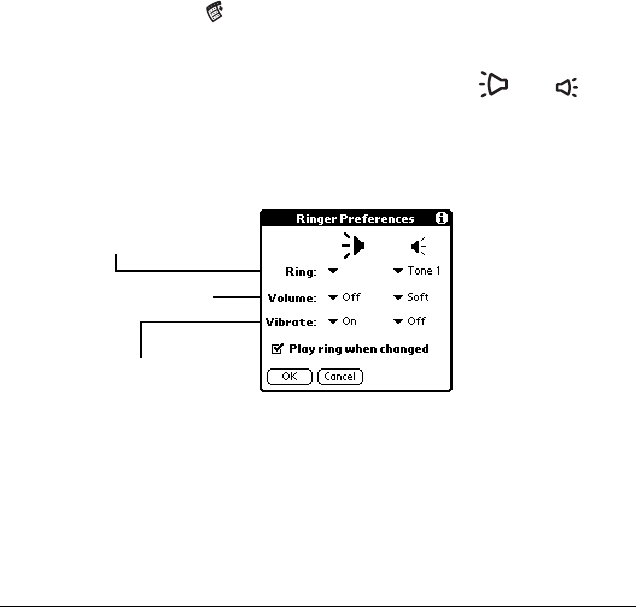
Customizing Your Phone 65
Selecting the ringer settings
1. Tap the Menu icon .
2. Under Options, tap Ringer Preferences.
Tip: The slider on your phone has two positions and . The
two Ringer Preferences columns control the behavior of the
corresponding slider position.
3. Select the ringer settings you want to use.
Tip: You can use both a ring tone and vibrate alert or use them
separately. For example, you can set one position to ring softly
and vibrate, and the other position to vibrate only. To preview
a new sound, select Play ring when changed.
4. Tap OK.
Tap Ring pick lists to
select ring style
Tap Volume pick lists to
select volume level
Tap Vibrate pick lists to turn
vibrate mode on or off
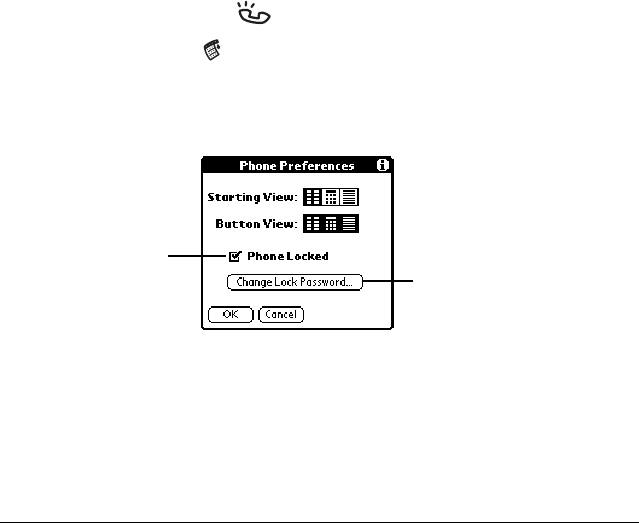
66 Customizing Your Phone
Preventing unauthorized use
You can protect your phone number from unauthorized use by locking your
SIM card.
1. Turn on your phone.
2. Press the Phone button on your VisorPhone.
3. Tap the Menu icon .
4. Under Options, tap Phone Preferences.
5. Select the Phone Locked check box to lock your SIM card.
6. Enter your password and tap OK.
Note: If you haven’t set a password yet, check your service provider’s
documentation for the default password. This is usually 1234.
7. Tap OK.
Tap here to lock
and unlock the
SIM card Tap here to define a
new password
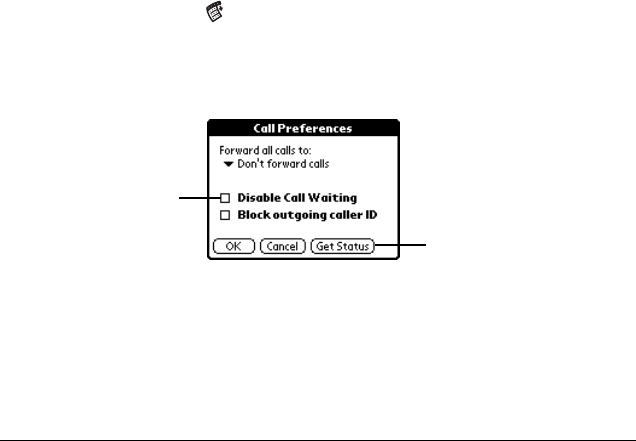
Customizing Your Phone 67
Disabling call waiting
If you receive a call while you are talking on the phone, the Phone
application notifies you about the second call. If you don’t want to be
interrupted by other calls, you can disable call waiting.
Note: Because call waiting information is stored by the network, it’s a
good idea to check the current network settings both before and
after you change the call waiting option.
1. Tap the Menu icon .
2. Under Options, tap Call Preferences.
3. Disable the call waiting option.
4. Tap OK.
Tip: To reactivate Call Waiting, remove the check from the Disable
Call Waiting check box.
Tap here to disable
call waiting
Tap here to display current
network settings
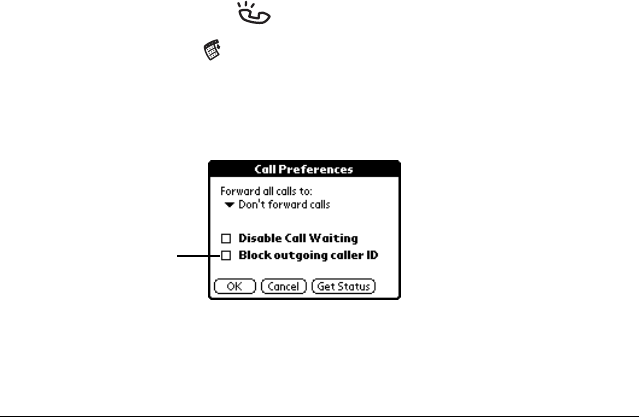
68 Customizing Your Phone
Blocking your phone number for outgoing calls
When you place a call from your VisorPhone, the Phone application reveals
your phone number to the person you’re calling. If your service provider
supports caller ID blocking, you can prevent revealing your phone number
to people you call.
Note: Because caller ID blocking information is stored by the network, it’s
a good idea to check the current network settings both before and
after you change the Block outgoing caller ID option.
1. Press the Phone button on your VisorPhone.
2. Tap the Menu icon .
3. Under Options, tap Call Preferences.
4. Enable the Block outgoing caller ID option.
5. Tap OK.
Tap here to place
anonymous calls
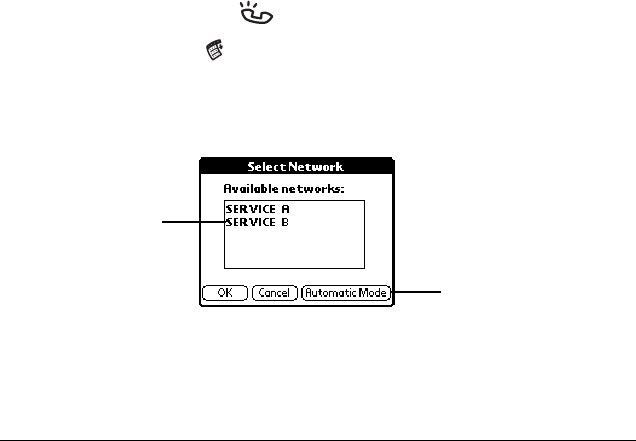
Customizing Your Phone 69
Selecting a service provider network
If you roam to an area where multiple service providers offer coverage, your
VisorPhone automatically selects the provider with the strongest signal.
However, if you prefer, you can manually select a service provider network.
Note: When you manually select a network, your VisorPhone finds only
that network until you either choose another network, or return to
Automatic Mode.
1. Press the Phone button on your VisorPhone.
2. Tap the Menu icon .
3. Under Options, tap Select Network.
4. Select a network.
5. Tap OK.
Note: Selecting a new network may take 30 seconds or more.
Tap a network
to enter manual
mode
Tap Automatic Mode
to return to automatic
search mode

70 Customizing Your Phone
Connecting a headset
Use the built-in speaker and microphone or connect an optional headset for
hands-free operation. For best results, use only headsets from Handspring.
Headset
jack

Using the Menus 71
Using the Menus
This section provides an overview of the menu options available in the
Phone and SMS Message Manager applications. Some of the menu options
vary based on which screen is active.
Phone application Edit menus
Edit Speed Dial: Opens a dialog where you can define, change, and delete
speed dial buttons. For details, see “Changing a speed dial entry” on page
38.
Paste: Inserts a phone number from the clipboard into the dial box.
Phone application Record menu
Purge: Opens a dialog where you can remove selected records from the Call
History list. For details, see “Purging call history” on page 34.
Delete Item: Removes the selected record from the Call History list.
Speed Dial view Dialpad view
Call History view
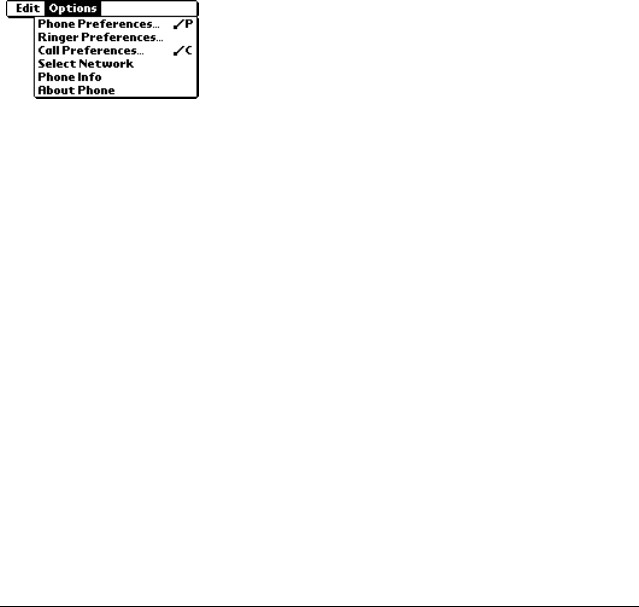
72 Using the Menus
Phone application Options menu
Phone Preferences: Opens a dialog where you can change your phone display
and lock the phone. For details, see “Changing the phone display” on page
64 and see “Preventing unauthorized use” on page 66.
Ringer Preferences: Opens a dialog where you can choose the ringer settings.
For details, see “Selecting the ringer settings” on page 65.
Call Preferences: Opens a dialog where you can choose call waiting, call
blocking, and call forwarding settings. For details, see “Disabling call
waiting” on page 67, “Blocking your phone number for outgoing calls” on
page 68, and “Forwarding calls” on page 22.
Select Network: Opens a dialog where you can search for and use networks
other than your default network. For details, see “Selecting a service
provider network” on page 69.
Phone Info: Opens a dialog where you can view information about your phone
such as the phone number and the IMEI number that uniquely identifies
your phone to the network.
About Phone: Opens a dialog where you can view version and copyright
information for the Phone application.
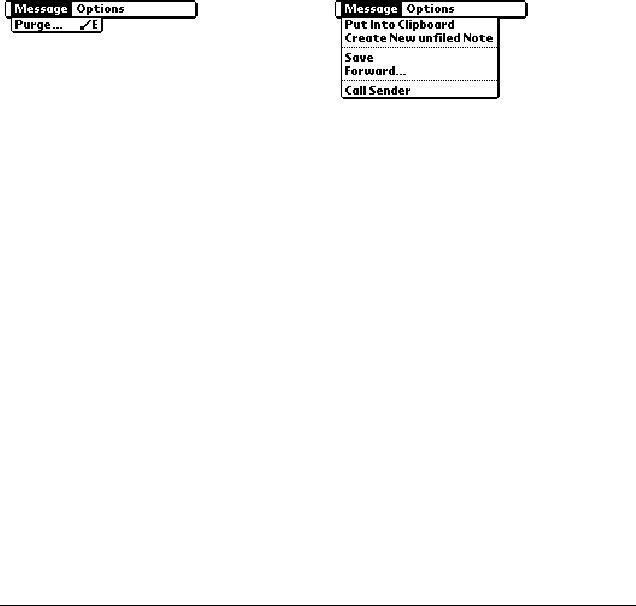
Using the Menus 73
SMS Message Manager application Message menus
Delete: Opens a dialog where you can choose which messages you want to
remove from the Inbox. For details, see “Deleting messages” on page 52.
Put Into Clipboard: Copies the selected text to the clipboard so you can paste
it into another message or application. For details, see “Copying message
text” on page 49.
Create New Note: Copies the selected text to a new Memo Pad memo. For
details, see “Copying message text” on page 49.
Save: Stores the selected message in the Saved category.
Forward: Creates a copy of the selected message so you can send it to
someone else. For details, see “Forwarding incoming messages” on page 50.
Call Sender: Dials the person who sent the message.
Inbox view
Message view
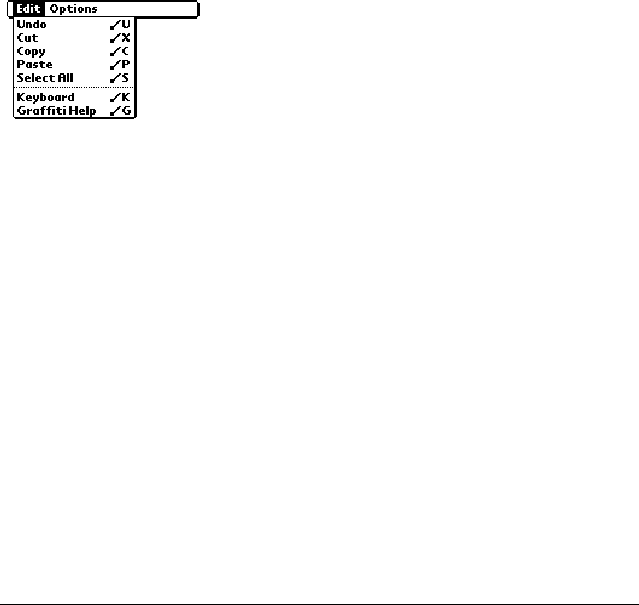
74 Using the Menus
SMS Message Manager application Edit menu
Undo: Clears the last action.
Cut: Removes the selected text and places it on the clipboard.
Copy: Copies the selected text and places it on the clipboard.
Paste: Inserts text stored on the clipboard at the current cursor position.
Select All: Selects all text in the current record.
Keyboard: Opens the onscreen keyboard.
Graffiti Help: Opens screens that show you how to form Graffiti characters.

Using the Menus 75
SMS Message Manager application Option menu
Font: Opens a dialog where you can choose the font you want to use.
Greeting: Opens a dialog where you can enter predefined opening and
closing phrases to use in your messages.
Preferences: Opens a dialog where you can view the SMS Service Center
number (if this field is blank, contact your service provider for this
information), choose deletion confirmation, and enter your service
provider’s SMS Email Center number. For details, see “Enabling SMS
Email” on page 53.
About SMS: Opens a dialog where you can view version and copyright
information for the SMS Message Manager application.

76 Using the Menus

Troubleshooting and Maintenance 77
Troubleshooting and Maintenance
If you encounter a problem with your VisorPhone module, check this
section to see if your problem is listed. If your problem isn't listed here, or
the suggestions don't resolve your problem, visit www.handspring.com for
the latest troubleshooting and customer support information.
My VisorPhone
won't turn on
■Make sure your VisorPhone is inserted firmly in the
Springboard expansion slot.
■Make sure your VisorPhone battery isn't drained.
■When you turn on your VisorPhone, hold down the
power button for at least two seconds, until you hear
a beep.
■Turn on your handheld to make sure that the
handheld batteries aren't drained. Low batteries will
prevent your VisorPhone from turning on.
I get a message
that my SIM
card is missing
when I turn on
my VisorPhone
■Make sure your SIM card is properly inserted. The
metal contacts must face down (away from the
battery), and the side with the corner cut must slide
into the SIM slot first. For details, see “Step 3: Insert
your SIM card” on page 5.
■Your SIM card may be damaged. Contact your
service provider for a new card.

78 Troubleshooting and Maintenance
My VisorPhone
requires an
unlocking code,
but I didn't set
one
■Your service provider may have set the locking code
before you received your VisorPhone. Enter the
default unlocking code: 1234 and then tap OK. If
this doesn't work, contact your service provider.
Note: It is actually locked your SIM card that is
locked, not your VisorPhone.
■If you see the Unblock Phone instead of the Unlock
Phone screen, you entered the unlocking code
incorrectly more than three times, and your
VisorPhone is now blocked. Contact your service
provider to obtain the unblocking code.
I called my
service provider
to enable my
phone service,
but it still
doesn’t work
Some service providers require 24 hours or more to
activate your phone service. If it has been longer than
your service provider’s activation period, report the
problem to your service provider.
My phone
number isn't on
the Phone Info
screen
Your service provider may need to install your phone
number onto your SIM card. Contact your service
provider to see if they can send a message to your
VisorPhone that writes your phone number onto your
SIM card.

Troubleshooting and Maintenance 79
My VisorPhone
won't register to
the network
■You are probably outside a network coverage area.
Try using another GSM phone to verify whether
coverage is available in your current location.
■If coverage is available in your location, try your
SIM card in another GSM phone. If it still doesn’t,
work, your SIM card may be malfunctioning.
Contact your service provider for another SIM card.
■Turn off your VisorPhone, and then turn it on
again. If a dialog appears asking if you want to search
for a network, tap Yes.
I tried dialing a
phone number,
but my
VisorPhone just
beeps at me
■Make sure you dialed the correct number.
■Wait a few minutes and try again. If the network is
very busy, calls cannot connect.
■Verify that you are in a network coverage area and
then move a few yards away and try the call again. If
you are in a weak coverage area (1 bar of signal
strength or less), you may not be able to complete
calls even though you are registered to the network.
I can't dial
international
numbers
For security purposes, most service providers require
you to enable international calling on your account. Call
your service provider to enable international calling.
Call waiting
doesn’t work
Enable call waiting in the Call Preferences dialog box.
For details, see “Disabling call waiting” on page 67.

80 Troubleshooting and Maintenance
Call forwarding
doesn't work
For security purposes, most service providers require
you to enable this feature on your account even though
there is usually no extra charge. Call your service
provider to enable call forwarding.
Caller ID
blocking for my
outgoing calls
doesn't work
Some service providers require you to enable this feature
on your account. Call your service provider to enable
blocking your Caller ID.
Some people’s
names don’t
appear in Call
History
■Call History shows names only if the person's name
and the phone number they called from are in your
Address Book.
■Find out if a caller has blocked their Caller ID.
I can’t send SMS
Messages
■Check the SMS Preferences dialog box to see if the
SMS Message Center number is on this screen. If
the number is missing, contact your service provider
for the SMS Message Center number and enter it in
the SMS Preferences dialog box.
■Make sure SMS services are enabled on your
account.
■Verify that you are in a GSM coverage area.
■Make sure the destination number is correct. Some
service providers require 11-digit phone numbers
for SMS messages.

Troubleshooting and Maintenance 81
I get an error
message when I
send an SMS
message to an
email address
You need to enter the SMS Email Center number in the
SMS Preferences dialog box. This number is different
from the SMS Message Center number you use to send
messages to other mobile phone numbers. For more
information, see “Enabling SMS Email” on page 53.
Some phone
numbers don’t
appear in the
SMS Lookup
Make sure the number you want is identified as a mobile
number in your Address Book. Only mobile phone
numbers appear when you use the SMS Message
Manager Lookup button.
The applications
I assigned to the
Dial, Email, and
SMS or Phone
buttons in the
Dialing Address
Book don’t
launch
■Check the Dial Preferences dialog box in the
Address Book to confirm the application is assigned
to the Dial, Email, or SMS button. For details, see
“Assigning dialing applications” on page 63.
■Contact the software developer for the application
you want to use when you tap the button, and verify
that the software is compatible with the new Dialing
Address Book and the version of Palm OS your
VisorPhone uses. To take advantage of these
buttons, an application must contain special code
that registers its capabilities to the Address Book.
I can't make
data calls
■Verify that data calls are enabled on your account.
■Verify that you are in a coverage area.

82 Troubleshooting and Maintenance
Caring for your VisorPhone module
■Keep your VisorPhone and its accessories out of the reach of small
children.
■Keep you VisorPhone dry.
■Use your VisorPhone at normal temperatures (between -4 degrees and
130 degrees Fahrenheit). Temperatures outside of this range may cause
damage to your VisorPhone.
■Keep your VisorPhone away from dusty or dirty areas.
■Do not disassemble your VisorPhone.
■Do not use harsh detergents to clean your VisorPhone.
■Use only genuine Handspring accessories. Third party accessories are
not guaranteed to function properly with your VisorPhone.
■Do not let the Springboard contacts on your VisorPhone come in direct
contact with conductive or electronic objects.
■Do not short any contacts on your VisorPhone module or the
Springboard connectors.
I can't
synchronize
when my
VisorPhone is
connected to my
handheld
Make sure that there are no active calls on your
VisorPhone before you begin a HotSync operation. You
cannot synchronize while you have an active call, and
you cannot make or receive calls during a HotSync
operation.

Troubleshooting and Maintenance 83
Caring for the battery
Your VisorPhone uses a 680mAh Lithium Ion battery. A fully-charged
battery provides approximately 3 hours of talk time and more than 70 hours
of standby time. Follow these guidelines to get the most from your battery:
■Do not disassemble the battery pack.
■If you are not using your VisorPhone for an extended period of time,
disconnect the battery pack from the phone and store it in a cool, dry
place; charge the battery at least once every six months when not in use.
■Use your VisorPhone at normal temperatures (between -4 degrees and
130 degrees Fahrenheit). Using your VisorPhone outside of the normal
temperature range can severely decrease the battery performance.
■Never throw the battery pack into fire or expose it to extreme heat.
■If the battery pack ever becomes hot or smells odd, stop using it.
■If the battery pack becomes damaged and leaks liquid, stop using it and
avoid skin contact with the leaking liquid.
■Use only a genuine Handspring battery pack. Third party battery packs
are not guaranteed to function properly with your VisorPhone.
■Always replace the battery pack with the same type of pack. Using
another type of battery pack may cause an explosion.
■Do not short any battery contacts or let the contacts come in direct
contact with conductive or electronic objects.
■Be sure to properly dispose of the battery. For more information, see
“How do I dispose of the battery?” on page 84.
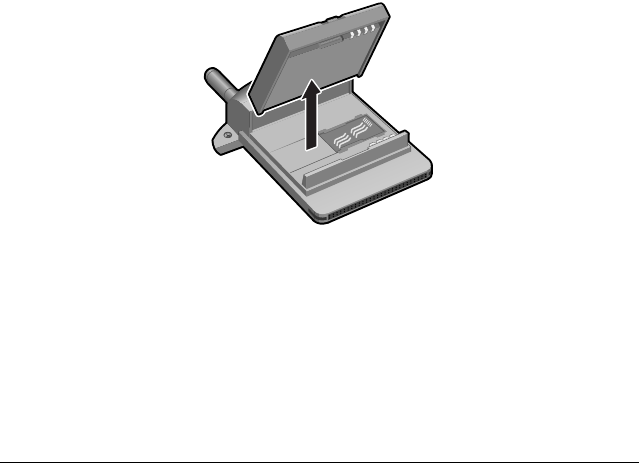
84 Troubleshooting and Maintenance
How do I dispose of the battery?
When your battery fails to hold a charge, you need to replace it.
Caution: It is illegal in many areas to dispose of Lithium Ion batteries in
household or business trash. Call your local recycling center for
instructions on battery recycling, or contact Handspring for safe
disposal options. Do not handle a damaged or leaking battery.

Warranty and Other Product Information 85
Warranty and
Other Product Information
Handspring, Inc. Limited Warranty
HARDWARE: Handspring, Inc. (“Handspring”), warrants to the original end user (“Customer”) that this
product will be free from defects in workmanship and materials, under normal intended use, for one year
from the date of original purchase from Handspring. Handspring's sole obligation under this express war-
ranty shall be, at Handspring's option and expense, to replace the product or part with a comparable product
or part, repair the product or part, or if neither repair nor replacement is reasonably available, Handspring
may, in its sole discretion, refund to Customer the purchase price paid for the product or part. Replacement
products or parts may be new or reconditioned. Handspring warrants any replaced or repaired product or
part, and any hardware upgrade to which Customer is entitled under an agreement between Customer and
Handspring, for a period of ninety (90) days from shipment, or through the end of the original warranty,
whichever is longer. All products or parts that are replaced become the property of Handspring.
Accessory products, as listed in the applicable Handspring catalogue, are not covered under this Limited
Warranty. Handspring shall not be responsible for Customer's software, firmware, information, or memory
data contained in, stored on, or integrated with any products returned to Handspring for repair, whether
under warranty or not.
SOFTWARE: Handspring warrants to Customer that the Desktop organizer software licensed from it will
perform in substantial conformance to their program specifications, for a period of ninety (90) days from the
date of original purchase from Handspring. Handspring warrants the media containing software against fail-
ure during the warranty period. No updates are provided. Handspring does not provide any warranty for any
third party applications software that is licensed to Customer by the third party. Handspring's sole obliga-
tion with respect to this express warranty shall be (at Handspring's discretion) to refund the purchase price
paid by Customer for any defective software product, or to replace any defective media with software which
substantially conforms to applicable Handspring published specifications. Handspring makes no warranty or
representation that its software products will meet Customer's requirements or will work in combination
with any hardware or applications software products provided by third parties, that the operation of the soft-
ware products will be uninterrupted or error free, or that all defects in the software products will be correct-
ed.
OBTAINING WARRANTY SERVICE: Customer must contact Handspring within the applicable war-
ranty period to obtain warranty service authorization. Dated proof of original purchase from Handspring
will be required. Handspring is not responsible for Customer products or parts received without a warranty
service authorization. In the United States, Handspring may ship a replacement product or part prior to re-

86 Warranty and Other Product Information
ceiving the original product or part (“advance exchange”). If advance exchange is not available, then the re-
paired product or part will be shipped as soon as reasonably possible, which will be no later than thirty (30)
days after Handspring receives the original product or part. Repaired or replacement products will be shipped
to Customer at Handspring's expense. The repair and replacement process for products or parts in locations
outside of the United States will vary depending on Customer's location.
Products or parts shipped by Customer to Handspring must be sent prepaid and packaged appropriately for
safe shipment, and it is recommended that they be insured or sent by a method that provides for tracking of
the package. When an advance exchange is provided and Customer fails to return the original product or part
to Handspring within thirty (30) days from the date the warranty service authorization is issued, Handspring
will charge Customer the then current published catalogue price of such product or part.
WARRANTIES EXCLUSIVE: IF THIS PRODUCT DOES NOT OPERATE AS WARRANTED
ABOVE, CUSTOMER'S SOLE REMEDY FOR BREACH OF THAT WARRANTY SHALL BE RE-
PLACEMENT OR REPAIR OF THE PRODUCT OR PART OR REFUND OF THE PURCHASE
PRICE PAID, AT HANDSPRING'S OPTION. TO THE FULL EXTENT ALLOWED BY LAW, THE
FOREGOING WARRANTIES AND REMEDIES ARE EXCLUSIVE AND ARE IN LIEU OF ALL
OTHER WARRANTIES, TERMS, OR CONDITIONS, EXPRESS OR IMPLIED, EITHER IN FACT
OR BY OPERATION OF LAW, STATUTORY OR OTHERWISE, INCLUDING WARRANTIES,
TERMS, OR CONDITIONS OF MERCHANTABILITY, FITNESS FOR A PARTICULAR PUR-
POSE, SATISFACTORY QUALITY, CORRESPONDENCE WITH DESCRIPTION, AND NON IN-
FRINGEMENT, ALL OF WHICH ARE EXPRESSLY DISCLAIMED BY HANDSPRING and ITS
SUPPLIERS. HANDSPRING NEITHER ASSUMES NOR AUTHORIZES ANY OTHER PERSON
TO ASSUME FOR IT ANY OTHER LIABILITY IN CONNECTION WITH THE SALE, INSTAL-
LATION, MAINTENANCE OR USE OF ITS PRODUCTS.
HANDSPRING AND ITS SUPPLIERS SHALL NOT BE LIABLE UNDER THIS WARRANTY IF
ITS TESTING AND EXAMINATION DISCLOSE THAT THE ALLEGED DEFECT OR MAL-
FUNCTION IN THE PRODUCT DOES NOT EXIST OR WAS CAUSED BY CUSTOMER'S OR
ANY THIRD PERSON'S MISUSE, NEGLECT, IMPROPER INSTALLATION OR TESTING, UN-
AUTHORIZED ATTEMPTS TO OPEN, REPAIR, OR MODIFY THE PRODUCT, OR ANY OTHER
CAUSE BEYOND THE RANGE OF THE INTENDED USE, OR BY ACCIDENT, FIRE, LIGHT-
NING, OTHER HAZARDS, OR ACTS OF GOD. THIS WARRANTY DOES NOT COVER PHYSI-
CAL DAMAGE TO THE SURFACE OF THE PRODUCT, INCLUDING CRACKS OR
SCRATCHES ON THE LCD TOUCHSCREEN OR OUTSIDE CASING. THIS WARRANTY DOES
NOT APPLY WHEN THE MALFUNCTION RESULTS FROM THE USE OF THIS PRODUCT IN
CONJUNCTION WITH ACCESSORIES, OTHER PRODUCTS, OR ANCILLARY OR PERIPHER-
AL EQUIPMENT AND HANDSPRING DETERMINES THAT THERE IS NO FAULT WITH THE
PRODUCT ITSELF. THIS WARRANTY DOES NOT APPLY TO ANY MALFUNCTION OR FAIL-

Warranty and Other Product Information 87
URE OF THE PRODUCT OR PART DUE TO ANY COMMUNICATION SERVICE CUSTOMER
MAY SUBSCRIBE TO OR USE WITH THE PRODUCT.
LIMITATION OF LIABILITY: TO THE FULL EXTENT ALLOWED BY LAW, HANDSPRING
ALSO EXCLUDES FOR ITSELF AND ITS SUPPLIERS ANY LIABILITY, WHETHER BASED IN
CONTRACT OR TORT (INCLUDING NEGLIGENCE), FOR INCIDENTAL, CONSEQUEN-
TIAL, INDIRECT, SPECIAL, OR PUNITIVE DAMAGES OF ANY KIND, OR FOR LOSS OF REV-
ENUE OR PROFITS, LOSS OF BUSINESS, LOSS OF INFORMATION OR DATA, OR OTHER
FINANCIAL LOSS ARISING OUT OF OR IN CONNECTION WITH THE SALE, INSTALLA-
TION, MAINTENANCE, USE, PERFORMANCE, FAILURE, OR INTERRUPTION OF THIS
PRODUCT, EVEN IF HANDSPRING HAS BEEN ADVISED OF THE POSSIBILITY OF SUCH
DAMAGES, AND LIMITS ITS LIABILITY TO REPLACEMENT, REPAIR, OR REFUND OF THE
PURCHASE PRICE PAID, AT HANDSPRING'S OPTION. THIS DISCLAIMER OF LIABILITY
FOR DAMAGES WILL NOT BE AFFECTED IF ANY REMEDY PROVIDED HEREIN SHALL
FAIL OF ITS ESSENTIAL PURPOSE.
NOTICE TO CONSUMERS: Some countries, states, or provinces do not allow the exclusion or limita-
tion of implied warranties or the limitation of incidental or consequential damages for certain products sup-
plied to consumers, or the limitation of liability for personal injury, so the above limitations and exclusions
may be limited in their application to you. When the implied warranties are not allowed to be excluded in
their entirety, they will be limited to the duration of the applicable written warranty. This warranty gives
you specific legal rights which may vary depending on local law.
GOVERNING LAW: This Limited Warranty shall be governed by the laws of the State of California,
U.S.A. as such laws are applied to agreements entered into and to be performed entirely within California
between California residents and by the laws of the United States, excluding its conflicts of laws principles
and excluding the United Nations Convention on Contracts for the International Sale of Goods.

88 Warranty and Other Product Information
Handspring, Inc. End User Software License Agreement
THIS PRODUCT CONTAINS SOFTWARE, THE USE OF WHICH IS LICENSED BY HAND-
SPRING, INC. AND ITS SUPPLIERS (COLLECTIVELY, “HANDSPRING”), TO ITS CUSTOMERS
FOR THEIR USE ONLY AS SET FORTH BELOW.
SOFTWARE LICENSE: Handspring grants you a nonexclusive license to use the accompanying software
program(s) (the “Software”) subject to the terms and restrictions set forth in this End User Software License
Agreement (“License Agreement”). You are not permitted to lease or rent, distribute or sublicense the Soft-
ware or to use the Software in a time-sharing arrangement or in any other unauthorized manner. Further, no
license is granted to you in the human readable code of the Software (source code). Except as provided below,
this License Agreement does not grant you any rights to patents, copyrights, trade secrets, trademarks, or any
other rights in respect to the Software.
The Software is licensed to be used solely on or in connection with Handspring products. With respect to the
Desktop Software, you may reproduce and provide one (1) copy of such Software for each personal computer
on which such Software is used as permitted hereunder. With respect to the Device Software, you may use
such Software only on one (1) Handspring product. Otherwise, the Software and supporting documentation
may be copied only as essential for backup or archive purposes in support of your use of the Software as per-
mitted hereunder. You must reproduce and include all copyright notices and any other proprietary rights no-
tices appearing on the Software on any copies that you make.
Notwithstanding any other provision of this License Agreement, this License Agreement shall not be deemed
to apply to any applications software licensed to you by third parties that is included on the same media as
Handspring's Software (“Other Software”) if the Other Software provides that the use of the Other Software
is subject to the terms and conditions of the third party's license agreement.
Portions of the Software are licensed to Handspring, and from Handspring to you, pursuant to the GNU Li-
brary General Public License (“GNU Software”), a copy of which is supplied herewith and incorporated
herein in its entirety by this reference. Notwithstanding any other provision of this License Agreement, this
License Agreement shall not be deemed to apply to the GNU Software. Source code versions of the GNU
Software are available at Handspring's web site, currently located at www.handspring.com.
PAYMENT OF FEES: The effectiveness of the licenses granted hereunder is conditioned on the receipt by
Handspring of any applicable fees.

Warranty and Other Product Information 89
NO ASSIGNMENT; NO REVERSE ENGINEERING: You may transfer the Software and this License
Agreement to another party in connection with a transfer of the Handspring product upon which the Soft-
ware is used, if the other party agrees in writing to accept the terms and conditions of this License Agree-
ment. If you transfer the Software, you must at the same time either transfer all copies of the Software as
well as the supporting documentation to the same party or destroy any such materials not transferred. Except
as set forth above, you may not transfer or assign the Software or your rights under this License Agreement.
Modification, reverse engineering, reverse compiling, or disassembly of the Software is expressly prohibited.
However, if you are a European Union (“EU”) resident, information necessary to achieve interoperability
of the Software with other programs within the meaning of the EU Directive on the Legal Protection of
Computer Programs is available to you from Handspring upon written request.
EXPORT RESTRICTIONS: You agree that you will not export or re-export the Software or accompa-
nying documentation (or any copies thereof) or any products utilizing the Software or such documentation
in violation of any applicable laws or regulations of the United States or the country in which you obtained
them. The software covered by this License Agreement may contain strong data encryption code which can-
not be exported outside of the U.S. or Canada. You agree that you will not export/reexport, either physically
or electronically, the encryption software or accompanying documentation without obtaining written autho-
rization from the U.S. Department of Commerce.
UNITED STATES GOVERNMENT LEGEND: If you are acquiring the Software on behalf of any unit
or agency of the United States Government, the following provisions apply. The Software constitutes a
“commercial item”, as that term is defined at Federal Acquisition Regulation (FAR) 2.101 (Oct. 1995), con-
sisting of “commercial computer software” and “commercial computer software documentation”, as such
terms are used in FAR 12.212 (Sept. 1995), and is provided to the U.S. Government only as commercial soft-
ware (with “Restricted Rights”, if applicable). Use, duplication, or disclosure by the U.S. Government is sub-
ject to restrictions set forth in this License Agreement and as provided in DFARS 227.7202-1(a) and
227.7202-3(a) (1995), DFARS 252.227-7013(c)(1)(ii) (OCT 1988), FAR 12.212(a) (1995), FAR 52.227-19,
or FAR 52.227-14 (ALT III), as applicable.
TERM AND TERMINATION: This License Agreement is effective until terminated. You may termi-
nate it at any time by destroying the Software and documentation together with all copies and merged por-
tions in any form. It will also terminate immediately if you fail to comply with any term or condition of this
License Agreement. Upon such termination you agree to destroy the Software and documentation, together
with all copies and merged portions in any form.

90 Warranty and Other Product Information
GOVERNING LAW: This License Agreement shall be governed by the laws of the State of California as
such laws are applied to agreements entered into and to be performed entirely within California between Cal-
ifornia residents and by the laws of the United States. You agree that the conflicts of laws principles of such
laws and the United Nations Convention on Contracts for the International Sale of Goods (1980) are hereby
excluded in its entirety from application to this License Agreement.
LIMITED WARRANTY; LIMITATION OF LIABILITY: All warranties and limitations of liability ap-
plicable to the Software are as stated on the Limited Warranty or in the product manual accompanying the
Software. Such warranties and limitations of liability are incorporated herein in their entirety by this refer-
ence.
SEVERABILITY: In the event any provision of this License Agreement is found to be invalid, illegal or un-
enforceable, the validity, legality and enforceability of any of the remaining provisions shall not in any way be
affected or impaired and a valid, legal and enforceable provision of similar intent and economic impact shall
be substituted therefor.
ENTIRE AGREEMENT: This License Agreement sets forth the entire understanding and agreement be-
tween you and Handspring, supersedes all prior agreements, whether written or oral, with respect to the Soft-
ware, and may be amended only in a writing signed by both parties.
Safety And General Information
IMPORTANT INFORMATION ON SAFE AND EFFFICIENT OPERATION. Read this information
before using your integrated multi-service portable radio.
For the Safe and Efficient Operation of Your Radio, Observe These Guidelines:
Your radio product contains a transmitter and a receiver. When it is ON, it receives and transmits radio fre-
quency (RF) energy. The radio operates in the frequency range of 800 MHz to 1990 MHz and employs digital
modulation techniques. When you use your radio, the system handling your call controls the power level at
which your radio transmits. The output power level typically may vary over a range from .001 Watts to 2
Watts.

Warranty and Other Product Information 91
Exposure To Radio Frequency Energy
Your VisorPhone Radio Product is designed to comply with the following national and international stan-
dards and guidelines regarding exposure of human beings to radio frequency electromagnetic energy:
■United States Federal Communications Commission, Code of Federal Regulations; 47 CFR part 2
sub-part J
■American National Standards Institute (ANSI) IEEE. C95. 1-1992
■National Council on Radiation Protection and Measurements (NCRP). Report 86
■International Commission on Non-Ionizing Radiation Protection (ICNIRP) 1998
■National Radiological Protection Board of the United Kingdom, GS 11, 1988
■Verband Deutscher Elektrotechniker (VDE) DIN-0848
■Department of Health and Welfare Canada. Safety Code 6
To assure optimal radio performance and make sure human exposure to radio frequency electromagnetic
energy is within the guidelines set forth in the above standards, always adhere to the following procedure:
When placing or receiving a phone call hold the radio as you would a telephone. Speak directly into the mi-
crophone and position the antenna up over your shoulder.
For body-worn operation, the antenna should be kept at least one inch from the body when transmitting. A
carry holder with a belt clip is available from handspring.com for body-worn use.
When using any data feature of the radio, with or without an accessory cable, position the antenna of the
radio product at least one inch (2.5 cm) away from the body.
DO NOT hold the antenna when the radio is “IN USE.” Holding the antenna affects call quality and may
cause the radio to operate at a higher power level than needed.
Interference to Medical and Personal Electronic Devices
Most electronic equipment is shielded from RF energy. However, certain equipment may not be shielded
against the RF signals from your wireless phone.

92 Warranty and Other Product Information
Pacemakers
The Health Industry Manufacturers Association recommends that a minimum separation of six inches (6")
be maintained between a handheld wireless phone and a pacemaker to avoid potential interference with the
pacemaker. These recommendations are consistent with the independent research by the recommendations
of Wireless Technology Research.
Persons with pacemakers should:
■ALWAYS keep the phone more than six inches from their pacemaker when the phone is turned ON.
■not carry the phone in a breast pocket.
■use the ear opposite the pacemaker to minimize the potential for interference.
■turn the phone OFF immediately if you have any reason to suspect that interference is taking place.
Hearing Aids
Some digital wireless phones may interfere with some hearing aids. In the event of such interference, you may
want to consult your hearing aid manufacturer to discuss alternatives.
Other Medical Devices
If you use any other personal medical device, consult the manufacturer of your device to determine if it is ad-
equately shielded from external RF energy. Your physician may be able to assist you in obtaining this infor-
mation.
Turn your phone OFF in health care facilities when any regulations posted in these areas instruct you to do
so. Hospitals or health care facilities may be using equipment that could be sensitive to external RF energy.
Interference to Other Electronic Devices
RF energy may affect improperly installed or inadequately shielded electronic operating and entertainment
systems in motor vehicles. Check with the manufacturer or representative to determine if these systems are
adequately shielded from external RF energy. Also check with the manufacturer of any equipment that has
been added to the vehicle.
Turn your radio OFF before boarding any aircraft to prevent possible interference to aircraft systems. Reg-
ulations of the United states Federal Aviation Administration prohibit use when the aircraft is in the air and
require you have permission from a crew member to use your radio while the aircraft is one the ground.

Warranty and Other Product Information 93
Safety and General Use While Driving
Check the laws and regulations on the use of telephones in the area where you drive. Always obey them.
When using the phone while driving, please:
■Give full attention to driving and to the road
■Use hands-free operation, if available
■Pull off the road and park before making or answering a call if driving conditions so require.
Canadian RFI Statement
This Class B digital apparatus meets all requirements of the Canadian Interference-Causing Equipment
Regulations.
Cet appareil numérique de la classe B respecte toutes les exigences du Réglement sur le matériel brouilleur
du Canada.
Acknowledgments
We would like to thank the following developers whose contributions were an integral part of the Hand-
spring product:
■Rindel & Partner GmbH
OPTION International Group
www.rindle.de
■OPTION International Group
www.option.com

94 Warranty and Other Product Information

Index 95
Index
Numerics
3-way calling 27
A
Active call 11, 23
Address Book
adding from Call History 14
adding to Speed Dial 37
dialing from 15
Dialing Preferences 63
Adjusting volume 4
Answering calls 19–21
Antenna 3
B
Battery
care 83
charging 7
disposal 84
gauge 11
indicators 7
location 3
specifications 83
Beep tone 21
Buttons
Phone 4
power 3
ringer 4
scroll 4, 13, 42
slider 4
SMS Message Manager 4
C
Call
Preferences 21, 22, 67, 68, 72
status 24, 26, 27
waiting 21, 67
Call History 17
adding to Address Book 14
adding to Speed Dial list 14
deleting items 34
dialing from 14
displaying 33
icon 14
incoming calls 33
missed calls 17, 29, 30, 33
outgoing calls 33
purging 34
Caller ID 17, 20, 21, 32, 68

96 Index
Calls
3-way 27
active 11, 23
answering 19–21
answering call waiting 21
conference 27
forwarding 22
ignoring 20
incoming 19–22, 33
missed 17, 30, 33
outgoing 11–18, 33, 68
placing a second 25
placing on hold 24
switching 26
Conference calls 27
Coverage area 10, 17, 19, 22, 29,
44, 48
D
Deleting
Call History 34
SMS messages 32, 44, 52
Speed Dial entries 39
Dialing
applications 63
emergency numbers 18
from Address Book 15
from Call History 14, 30, 33
from Memo Pad 16
from To Do List 16
last number 14
prefixes 62
previous numbers 13, 14, 33
with Dialpad 13
with Speed Dial 12
Dialpad
dialing numbers 13
icon 13
E
Edit
call forwarding number 22
menu 71, 74
phone number 13, 15, 16, 37
SMS messages 49, 50
Speed Dial 38, 40
Email messages 41, 43, 46, 53
Emergency numbers 18
F
Forwarding
calls 22
SMS Email 53
SMS messages 50, 73

Index 97
Frequently asked questions 77–82
G
Greetings 47
H
Headset
connecting 70
jack 3
Hold button 24
HotSync operations 55–59, 82
I
Icons
battery 11
Call History 14, 30
Dialpad 13
signal strength 11
Speed Dial 12
Voicemail 11
Ignoring calls 20
Incoming calls 19–22, 33
Indicators
battery 4, 7, 11
Call History 33
call status 24, 26, 27
call waiting 21
missed call 17
network service 4, 10, 11
signal strength 11
voicemail 11
K
Key Pad 11, 12, 31
L
LED 3, 4, 7, 10
License agreement 88
Light, see LED 4
Limited warranty 85
Locking phone 66
M
Memo Pad 16
Menus
Phone application 71–72
SMS Message Manager 73–75
Message
Manager, see SMS
menus 73
status 48
Messages
checking 29–33
expiration 48

98 Index
missed call 17
purging SMS 52
replying 43
sorting SMS 51
text 10, 29, 32, 42
voicemail 10, 31
Missed calls 17, 30, 33
Modem 55–59
Module
inserting 6
removing 6
N
Network
coverage area 10
HotSync operation 58
name 11
selecting 69, 72
status 4, 68
voicemail number 36
Network status 22, 67
O
Options
Call Preferences 67, 68
call waiting 67
menu 72, 75
Phone Preferences 64
Ringer Preferences 65
Outgoing calls 11–18, 33, 68
P
Password 8, 66
Phone application
starting 13
Phone button 4
Phone number
checking 9
editing 13
Power button 3
Preferences
Call 68
call waiting 67
dialing 63
Phone 64
ringer 65
Prefixes 62
Purging
Call History 34
SMS messages 52
R
Record menu 71
Redialing a number 14

Index 99
Ringer
button 4
settings 65
S
Safety 10, 83, 90–93
Scroll buttons 4, 13, 42
Security 66
Setup 2–9
Signal strength 11, 69
Signatures 47
SIM card
defined 1, 5
IMEI 9
inserting 5
locking 66
phone number 9
SMS Message Center number
53
Slider 3, 4, 65
SMS
changing messages 49
copying text 49
creating messages 44
email messages 46, 53
forwarding messages 50
greetings 47
Inbox 42
menus 73–75
message expiration 48
Message Manager button 4
messages 29, 32
Preferences 53
purging messages 52
replying to messages 43
saving messages 48
signatures 47
sorting messages 51
Software license 88
Sorting messages 51
Speaker 3, 4, 70
Speed Dial
adding Address Book entries
37
adding Call History entries 14
changing entries 38
defining buttons 36
deleting entries 39
dialing numbers 12
icon 12
list 35–40
organizing 35, 40
voicemail 31, 36
